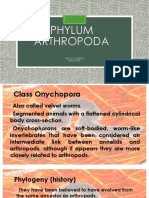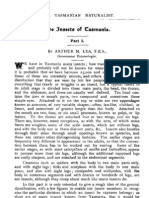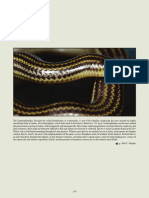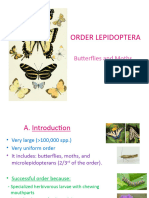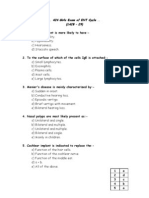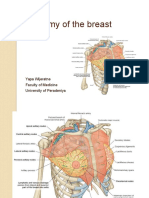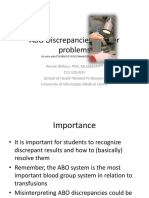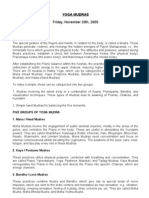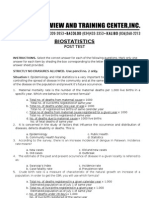Professional Documents
Culture Documents
Linyphiidae FV
Uploaded by
cinifeOriginal Description:
Original Title
Copyright
Available Formats
Share this document
Did you find this document useful?
Is this content inappropriate?
Report this DocumentCopyright:
Available Formats
Linyphiidae FV
Uploaded by
cinifeCopyright:
Available Formats
124
Linyphiidae
Chapter 35
Final version
LINYPHIIDAE
157 genera, 952 species
Common name Sheet-web spiders. Erigoninae are sometimes called dwarf spiders or money spiders. Similar families Many small ground-dwelling spiders in other families have been mistaken for linyphiids, including Dictynidae (Lathys, p. 94), Mysmenidae (p. 175, Microdipoena), Theridiidae (p. 235, Robertus, Thymoites, Pholcomma, Theonoe), Tetragnathidae (p. 232, Glenognatha), Leptonetidae p. 121, Theridiosomatidae p. 242, and especially Pimoidae p. 195, which is the sister taxon to Linyphiidae (Hormiga 1994a, 2003). Diagnosis Minute to small (<17 mm) three-clawed, ecribellate, entelegyne spiders belonging to the superfamily Araneoidea. They may be distinguished from other Araneoids, except Pimoidae, by the following combination of characters: male palp with discrete, intersegmental paracymbium (rarely lost); stridulatory striae on the ectal side of the chelicerae (occasionally absent) and autospasy of the legs at the patella-tibia junction. Linyphiids and pimoids share cheliceral striae and patella-tibia autospasy. Linyphiids differ from pimoids in having a discrete paracymbium rather than one integrated with the cymbium, having the embolus part of a complex embolic division rather than attached directly to the tegulum, and by lacking a retrolateral cymbial sclerite attached to the cymbium via a membrane, which is a pimoid synapomorphy. Characters body size: from less than 1.0 to 7 mm; most are 1-4 mm long. color: white, tan, brown to black. Occasionally shades of orange, red, and yellow. Some species (especially larger arboreal species) may have dorsal abdominal stripes, chevrons, or markings; or banded legs. carapace: longer than wide; the carapace of many male linyphiids is modified in various ways. Eye region commonly elevated, sometimes exhibits bizarre forms. A pair of lateral pits may be present, opening near the posterior median eyes. Various clypeal protuberances or modifications, unusual setae or clusters of setae, or teeth around the carapace margin may be observed. sternum: longer than wide, projecting behind coxae IV. eyes: usually eight subequal eyes in two rows. Rarely reduced or absent (in cavernicolous species). Eyes of males with modified carapaces often in unusual configurations. chelicerae: relatively robust for Araneoid spiders, armed with teeth on both margins. Most with a stridulatory file on the lateral face. Some males have a mastidion or similar tooth-like apophysis on the anterior cheliceral face (e.g., Zornella). mouthparts: endites are parallel, rarely armed with apophyses in males (e.g., some Erigone spp.). legs: rather long and thin, with macrosetae. Autospasy occurs at the patella-tibia joint. All have a single meta-
Michael L. Draney Donald J. Buckle
Fig. 35.1 Ceraticelus fissiceps (O. PICKARD-CAMBRIDGE 1874)
tarsal trichobothrium on legs I-III, and some also have one on leg IV. Setation on legs of males often somewhat reduced compared to females. abdomen: usually ovoid to somewhat elongate. Some species have abdominal scuta (dorsal and sometimes ventral) of varying size. spinnerets: colulus present, with setae. Spinnerets are of typical araneoid form. respiratory system: one pair of book lungs, and a tracheal system opening onto a single spiracle anterior to the spinnerets, anteriorly displaced in some species (e.g., Tennesseellum). Most members of the subfamily Linyphiinae have unbranched tracheae confined to the abdomen while most members of the Erigoninae have branched tracheae extending into the cephalothorax. genitalia: entelegyne; female epigynum highly variable; usually fairly simple, plate-like sclerotized structure with a dorsal and a ventral sclerite associated with paired copulatory openings, leading via complex ducts to spermathecae. These sclerotized structures are sometimes, particularly in the Linyphiinae, modified into a posteriorly directed scape; male palps nearly always have an intersegmental paracymbium (=flexibly attached). The embolus is part of a complex structure called the embolic division, attached by a stalk to the suprategulum. This and several other sclerites associated with the tegulum, subtegulum, and suprategulum produces structurally complex palp. Erigonines nearly always have a retrolateral tibial apophysis of varying size and shape, sometimes consisting of multiple projections.
Spiders of North America
Linyphiidae
125
Distribution Worldwide with its greatest diversity in the north temperate regions. Well represented in North America. Natural history Linyphiids spin semi-permanent webs consisting of one or more horizontal sheet of silk often supported above and below by auxiliary support lines. The spider generally hangs upside down beneath the sheet, attacking prey from below. Most species live in leaf litter or on the ground surface, but some (especially larger species) make webs in vegetation. Both myrmecophiles and cavernicoles are known. Linyphiids generally feed on soft-bodied insects, especially springtails (Collembola) and flies (Diptera). They occupy almost all habitats but are most diverse and abundant in more mesic to hydric (i.e., wetlands) areas, and are prominent in northern peatlands. Most species are univoltine or annuals (one generation/year), but multivoltine (>1 generation/year) and merovoltine (>1 year/generation) strategies are common. Most species occur as adults for only a short period each year, but some multivoltine and merovoltine species are active as adults during most or all of the year. Most species overwinter as juveniles or adults, - some are even active under snow in winter - but a few overwinter as eggs. Taxonomic history and notes Linyphiidae is a large, poorly known, and taxonomically difficult family. Several genera and many species remain undescribed. While a number of North American genera have recently been revised, most have not. Their species are known from original descriptions, scattered through 150 years of literature, and from subsequent references under a variety of genus and species names. Eugen von Keyserling, Octavius Pickard-Cambridge, and Nathan Banks were prolific early describers of North American species, each adding over 30 currently valid species. The first, and only, comprehensive survey of North American linyphiids was published by James Emerton in 1882. He subsequently produced a series of papers describing many new species. Cyrus Crosby and Sherman Bishop published a series of revisionary studies in the 1920s and 1930s. Wilton Ivie, often working with Ralph Chamberlin, described many western species and revised several genera before his untimely death in 1969. Between 1968 and 1981 Peter van Helsdingen, revised Linyphia, Neriene, Microlinyphia, Stemonyphantes and Allomengea on a worldwide basis and Centromerus and Oreonetides for North America. In the 1980s, Frank Millidge, revised many North American genera, including Walckenaeria, Spirembolus and Eperigone, and described over 100 species. Buckle et al. (2001) provides an annotated catalog of North American taxa, and Hormiga et al. (2003) contains illustrations of all valid linyphiid genera worldwide. Paquin & Duprr (2003) provide illustrations of all species known from Quebec. This an invaluable reference for anyone working on linyphiids from northern and eastern North America. For a significant number of species it provides the first good illustrations or the first illustration of previously undocumented males or females. The higher level classification of the linyphiids is not presently clear. While the subfamily Erigoninae is considered to be monophyletic (Hormiga 2000) the Linyphiinae, in its classical sense, is not (Millidge 1984, Hormiga 2000). We evade this problem by considering everything not included in the Erigoninae to be a linyphiine. An additional problem is defining the limits of the Erigoninae.
Typical linyphiines and erigonines can be distinguished by several characters. However, there are a dozen or so genera which possess some but not all of the defining characters, in various assortments. These genera have, over the years, been shuffled back and forth between the subfamilies by various authors. Here we follow Hormiga (2000) who considers most to be basal erigonines. This key includes all linyphiid males and linyphiine females. Insufficient information is available at this time to permit construction of a key to erigonine females. There is no simple, straightforward way to distinguish between female linyphiines and erigonines. Almost all linyphiines have 2 dorsal spines on tibia IV, while many erigonines have only 1 or none. Many linyphiines have prolateral spines on tibia I and/or femur I while most erigonines do not. Many linyphiines have epigynal scapes, while most erigonines do not. Erigonines are small, while linyphiines may be small or medium sized; any linyphiid over 3.5 mm is likely to be a linyphiine. Species with patterned abdomens are common in the Linyphiinae, unusual in the Erigoninae. Females of the larger linyphiine genera have palpal claws while those of the erigonines and smaller linyphiines do not. Clitolyna electa and Masikia are not included in the key because males are unknown. The male of Pacifiphantes magnificus is unknown so Pacifiphantes is omitted from the male section of the key. Styloctetor keys out with Ceratinopsis because we were unable to find a way to consistently separate the two taxa. We key out two common western species which probably form an undescribed genus (Spirembolus vasingtonus, nomen dubium and Collinsia wilburi). We also include an undescribed western genus containing Spirembolus approximatus and other undescribed species, currently being examined and defined by J. Miller and T. Prentice, and another containing Linyphia rita, Linyphia catalina and Linyphia tauphora. Generic treatment here differs in various small ways from the current World Catalog. Meioneta is considered to be a synonym of Agyneta, following Saaristo (1973), Collinsia is treated as a synonym of Halorates (see Buckle et al. 2001) and Nanavia monticola CHAMBERLIN & IVIE, which was erroneously synonymized with Leptorhoptrum robustum (Westring 1851) by Eskov and Marusik (1994), has been restored to Nanavia. The recent deconstruction of Lepthyphantes into many small genera by Tanasevitch and Saaristo generated serious problems in the creation of this key. Only about half of the American Lepthyphantes species have yet been placed in the new genera, and some of the genera are based on characters possessed by one sex only. The only viable solution was to retain Lepthyphantes in the key in its old, broad sense. Students wishing to apply the Tanasevitch & Saaristo names can follow an identification technique long used for American linyphiids -thumb through the literature, looking at illustrations, until the species, or a close relative is located, then check a catalog to determine its current placement. Definitions used in this key The following characters are useful for separating the vast number of species into smaller, more manageable groups. However, using these requires separating continuously varying characters into discrete groups, and is necessarily a somewhat subjective process. We provide the following precise definitions to minimize the subjectivity. Some questionable taxa also key out in more than one place, when the interpretation of these characters is inherently difficult.
126
Linyphiidae
Metatarsal trichobothria: A trichobothrium (Tm) is a long, very fine hair emerging from a pit (which looks like a distinct circle) on the dorsal surface of a leg. They often stand nearly perpendicular to the leg surface. Linyphiids have 1 trichobothrium on each metatarsus, but it may be absent from metatarsus IV. The relative position of TmI is sometimes useful as a character; we indicate this position as the decimal fraction of a/b, as shown in Fig. 35.2. More accurate measurements will be obtained if the entire metatarsus is in focus under the microscope. See Roberts (1987) for further explanations and figures of trichobothria. Length of palpal tibia: The minimum distance parallel to the long axis of the tibia, between the point where the tibia and patella contact, and the point where the tibia contacts the tarsus (i.e., a palpal structure distal to the tibia, Figs. 35.3-35.5b). Width of palpal tibia: The minimum diameter of the tibia, perpendicular to the long axis of the tibia, in the dorsal or ectal view (Figs. 35.4-35.5b). Length of tibial apophysis: This is determined in dorsal or ectal view, whichever view the apophysis appears longest. In this view, the apophysis length is the straight line distance from the apical-most point to a point which appears to be midway along a line drawn across the base of the apophysis. This base is somewhat subjective, but the point at which the apophysis begins to expand (Figs. 35.3-35.5b).
Normal versus modified cephalic region: The normal or unmodified linyphiid carapace is slightly raised or lobed in linyphiids (Figs. 35.6, 35.20, 35.120, 35.121), but a modified carapace is noticeably more raised (Fig. 35.57, 35.58) or raised in a distinctive way -the angle of the posterior declivity may be more acute than normal in lateral view, for example, producing a relatively sharp (but not particularly high) lobe (Fig. 35.165), or the entire carapace may be somewhat raised, or the posterior declivity of the cephalic region may be in an unusually posterior position, which is also considered modified (Fig. 35.203). Any noticeable protrusion or protuberance on the cephalic or clypeal region is also considered a modified carapace. Pits or excavations of an otherwise normal shaped carapace are not considered a cephalic modification, nor are any spines or projections of the lateral margins of the carapace (e.g., some Erigone species). Note on linyphiid palps: Many characters (such as the size and shape of the tibial apophysis) are best viewed from a certain orientation, and the best orientation often varies between species. Removing a palp from the body allows easy examination from various orientations, and can facilitate identification in many cases. Note that the left palpus is generally illustrated throughout this work, but many of the revisions of American linyphiids illustrate right palpi.
b a
TA
len gt
T length
35.3
35.2
TA
TA length
len gt h
TA length
T length
T length
T length
T width
T width
T width
35.4
35.5b
35.5a
Spiders of North America
Linyphiidae
127
Genera LINYPHIINAE Agyneta HULL 1911a, Allomengea STRAND 1912b, Anibontes CHAMBERLIN 1924a, Aphileta HULL 1920, Arcuphantes CHAMBERLIN & IVIE 1943, Bathyphantes MENGE 1866, Bolyphantes C.L. KOCH 1837g, Centromerita F. DAHL 1912b, Centromerus F. DAHL 1886, Drapetisca MENGE 1866, Estrandia BLAUVELT 1936, Florinda O. PICKARD-CAMBRIDGE 1896a, Frontinella F.O. PICKARD-CAMBRIDGE 1902a, Graphomoa CHAMBERLIN 1924a, Helophora MENGE 1866, Jalapyphantes GERTSCH & DAVIS 1946, Kaestneria WIEHLE 1956, Lepthyphantes MENGE 1866, Linyphantes CHAMBERLIN & IVIE 1942a, Linyphia LATREILLE 1804b, Macrargus F. DAHL 1886, Maro O. PICKARD-CAMBRIDGE 1906a, Microlinyphia GERHARDT 1928, Microneta MENGE 1869, Neriene BLACKWALL 1833c, Oaphantes CHAMBERLIN & IVIE 1943, Oreonetides STRAND 1901b, Oreophantes ESKOV 1984a, Pacifiphantes ESKOV & MARUSIK 1994, Pityohyphantes SIMON 1929, Poeciloneta KULCZYN SKI in CHYZER & KULCZYN SKI 1894, Porrhomma SIMON 1884a, Saaristoa MILLIDGE 1978b, Stemonyphantes MENGE 1866, Tapinopa WESTRING 1851, Taranucnus SIMON 1884a, Tennesseellum PETRUNKEVITCH 1925c, Wubana CHAMBERLIN 1919a ERIGONINAE Anacornia CHAMBERLIN & IVIE 1933a, Annapolis MILLIDGE 1984a, Anthrobia TELLKAMPF 1844, Arcterigone ESKOV & MARUSIK 1994, Baryphyma SIMON 1884r, Blestia MILLIDGE 1993a, Carorita DUFFEY & MERRETT 1964, Caviphantes OI 1960a, Ceraticelus SIMON 1884r, Ceratinella EMERTON 1882, Ceratinops BANKS 1905a, Ceratinopsidis BISHOP & CROSBY 1930, Ceratinopsis EMERTON 1882, Cheniseo BISHOP & CROSBY 1935c, Cnephalocotes SIMON 1884r, Coloncus CHAMBERLIN 1949, Coreorgonal BISHOP & CROSBY 1935c, Dactylopisthes SIMON 1884r, Dicymbium MENGE 1868, Dietrichia CROSBY & BISHOP 1933b, Diplocentria HULL 1911a, Diplocephalus BERTKAU in FRSTER & BERTKAU 1883, Disembolus CHAMBERLIN & IVIE 1933a, Dismodicus SIMON 1884r, Entelecara SIMON 1884r, Eperigone CROSBY & BISHOP 1928a, Epiceraticelus CROSBY & BISHOP 1931, Eridantes CROSBY & BISHOP 1933b, Erigone AUDOUIN 1826, Erigonella F. DAHL 1901c, Eskovia MARUSIK & SAARISTO 1999, Eulaira CHAMBERLIN & IVIE 1933a, Floricomus CROSBY & BISHOP 1925b, Glyphesis SIMON 1926, Gnathonargus BISHOP & CROSBY 1935c, Gnathonarium KARSCH 1881a, Gnathonaroides BISHOP & CROSBY 1938, Gonatium
MENGE 1868, Goneatara BISHOP & CROSBY 1935c, Gongylidiellum SIMON 1884r, Grammonota EMERTON 1882, Halorates HULL 1911a, Hilaira SIMON 1884a, Horcotes CROSBY & BISHOP 1933b, Hybauchenidium HOLM 1973, Hypomma F. DAHL 1886, Hypselistes SIMON 1894a, Islandiana BRAENDEGAARD 1932, Ivielum ESKOV 1988b, Jacksonella MILLIDGE 1951, Lessertia SMITH 1908, Lophomma MENGE 1868, Masikia MILLIDGE 1984a, Maso SIMON 1884r, Masoncus CHAMBERLIN 1949, Masonetta CHAMBERLIN & IVIE 1939a, Mecynargus KULCZYN SKI in CHYZER & KULCZYN SKI 1894, Metopobactrus SIMON 1884r, Micrargus F. DAHL 1886, Microctenonyx F. DAHL 1886, Mythoplastoides CROSBY & BISHOP 1933b, Nanavia CHAMBERLIN & IVIE 1933a, Oedothorax BERTKAU in FRSTER & BERTKAU 1883, Origanates CROSBY & BISHOP 1933b, Ostearius HULL 1911a, Paracornicularia CROSBY & BISHOP 1931, Pelecopsidis BISHOP & CROSBY 1935b, Pelecopsis SIMON 1864, Perregrinus TANASEVITCH 1992, Perro TANASEVITCH 1992, Phanetta KEYSERLING 1886b, Pocadicnemis SIMON 1884r, Procerocymbium ESKOV 1989b, Satilatlas KEYSERLING 1886b, Savignia BLACKWALL 1833a, Sciastes BISHOP & CROSBY 1938, Scirites BISHOP & CROSBY 1938, Scironis BISHOP & CROSBY 1938, Scolopembolus BISHOP & CROSBY 1938, Scotinotylus SIMON 1884r, Scylaceus BISHOP & CROSBY 1938, Scyletria BISHOP & CROSBY 1938, Semljicola STRAND 1906a, Silometopoides ESKOV 1990a, Sisicottus BISHOP & CROSBY 1938, Sisicus BISHOP & CROSBY 1938, Sisis BISHOP & CROSBY 1938, Sisyrbe BISHOP & CROSBY 1938, Sitalcas BISHOP & CROSBY 1938, Smodix BISHOP & CROSBY 1938, Soucron CROSBY & BISHOP 1936b, Souessa CROSBY & BISHOP 1936b, Souessoula CROSBY & BISHOP 1936b, Sougambus CROSBY & BISHOP 1936b, Souidas CROSBY & BISHOP 1936b, Soulgas CROSBY & BISHOP 1936b, Sphecozone O. PICKARD-CAMBRIDGE 1870d, Spirembolus CHAMBERLIN 1920a, Styloctetor SIMON 1884r, Subbekasha MILLIDGE 1984a, Symmigma CROSBY & BISHOP 1933b, Tachygyna CHAMBERLIN & IVIE 1939a, Tapinocyba SIMON 1884r, Thaleria TANASEVITCH 1984a, Thyreosthenius SIMON 1884r, Tibioplus CHAMBERLIN & IVIE 1947b, Tiso SIMON 1884r, Tmeticus MENGE 1868, Traematosisis BISHOP & CROSBY 1938, Tunagyna CHAMBERLIN & IVIE 1933a, Tusukuru ESKOV 1993, Tutaibo CHAMBERLIN 1916, Typhochrestus SIMON 1884r, Vermontia MILLIDGE 1984a, Wabasso MILLIDGE 1984a, Walckenaeria BLACKWALL 1833a, Zornella JACKSON 1932a, Zygottus CHAMBERLIN 1949
128
Linyphiidae
Key to genera North America North of Mexico
1
2(1)
Male ................................................................................... 2 Female (LINYPHIINAE only) ............................................ 197 With 2 dorsal spines on each tibia, or 1 dorsal spine on tibia IV and a prolateral spine on femur I; usually without a retrolateral apophysis on palpal tibia ........................... 3 With 1 or no dorsal spines on tibia IV and no prolateral spine on femur I; usually with a retrolateral apophysis on palpal tibia ...................................................................... 51
Linyphiinae and larger Erigoninae portion
(Hilaira, Nanavia, Sisicus, Sougambus, Thaleria, Tibioplus)
3(2)
4(3)
Prolateral spine present on tibia I .................................... 4 No prolateral spine on tibia I ......................................... 37 Some or all metatarsi with spines (check all legs) .......... 6 No metatarsi with spines .................................................. 5 Femur I with prolateral spine ........................................ 25 Femur I without prolateral spine ................................... 28 Abdomen with conspicuous caudal tubercle (Fig. 35.6); body red (fading in alcohol) except for palps, eye region and caudal tubercle which are black; palp as shown (Fig. 35.7) .................................................................... Florinda
Div. 1 species: Florinda coccinea (HENTZ 1850a) Dist. southeastern USA Ref. Blauvelt 1936
35.7 35.8 35.9
5(4)
6(4)
35.11 35.10
Abdomen without caudal tubercle; color brown or gray .. ............................................................................................ 7 Carapace pale with dark stripe bifurcating anteriorly (Figs. 35.8-35.9) ................................................................ 8 Carapace markings otherwise .......................................... 9 Dorsal stripe on carapace narrow (Fig. 35.8); terminal apophysis of palp twisted in a thick, tight spiral (Fig. 35.10); palp without patellar apophysis ........... Linyphia
Div. 1 introduced species: Linyphia triangularis (CLERCK 1757) Dist. ME Refs. Helsdingen 1969, Jennings et al. 2003
7(6)
8(7)
Dorsal stripe wider (Fig. 35.9); terminal apophysis not spiral (Fig. 35.11); palp with large patellar apophysis (Fig. 35.12) ................................................... Pityohyphantes
Div. 16 species Dist. n and w NA Ref. Buckle et al. 2001
35.13
35.12
9(7)
Cymbium of palp with dorso-basal horn tipped with tuft of hairs (Figs. 35.13-35.14) ........................ Allomengea
Div. 3 species Dist. n NA Ref. Helsdingen 1974 Note 2 of the species have matatarsal spines only on legs III & IV
10(9)
Cymbium otherwise ....................................................... 10 Embolus forming an apically directed loop (Fig. 35.15); lamina large and shield-like ...... Bathyphantes, in part
Div. 26 species, 2 key out here: Bathyphantes keeni (EMERTON 1917a) and B. reprobus (KULCZYNSKI 1916) Dist. widespread Ref. Ivie 1969
Not so .............................................................................. 11
35.14
35.15
Spiders of North America
Linyphiidae
129
11(10)
12(11)
Metatarsi with ventral spines ......................................... 12 Metatarsi without ventral spines ................................... 17 Tibia I with 2-5 pairs of ventral spines (Fig. 35.16) ...... 13 Tibia I with one pair of ventral spines or 1 to 4 single ones (Fig. 35.17) ...................................................................... 16 Terminal apophysis of palp twisted in a thick, tight spiral (Fig. 35.18) ........................................................... Neriene Terminal apophysis not spiral ........................................ 14 Embolus long and threadlike, making loop beyond confines of cymbium (Fig. 35.19); carapace elongate in cephalic region; chelicerae elongate, angled posteriorly (Fig. 35.20) ....................................................... Microlinyphia
Div. 4 species Dist. n and w NA Ref. Helsdingen 1970
35.16
35.17
13(12)
Div. 9 species Dist. widespread Ref. Helsdingen 1969 Note some authors consider Neriene to be a synonym of Linyphia
14(13)
Embolus remaining within confines of cymbium (Figs. 35.21-35.22), carapace and chelicerae normal .............. 15 Carapace pale with black median and marginal stripes: metatarsus I swollen (Fig. 35.23); palp as shown (Fig. 35.21) ................................................. Stemonyphantes
Div. 1 species: Stemonyphantes blauveltae GERTSCH 1951 Dist. n NA Ref. Helsdingen 1968
35.18
35.19
15(14)
35.20
Carapace uniform brown; metatarsus I not swollen; palp as shown (Fig. 35.22)...................... Undescribed genus
Div. Linyphia catalina GERTSCH 1951, Linyphia rita GERTSCH 1951 and perhaps Linyphia tauphora CHAMBERLIN 1928a Dist. sw USA Ref. Gertsch 1951
16(12)
Tibia I with pair of ventral spines near middle; palp with lamella of embolic division large and U-shaped (Fig. 35.24), Fickerts gland absent ........................ Helophora
Div. 4 species Dist. n and w NA Ref. Buckle et al. 2001
Tibia I with single ventral spine near base or 2-4 scattered ventral spines (Fig. 35.17); palp with lamella otherwise, Fickerts gland present (Fig. 35.25) ..................................... .................................................... Lepthyphantes, in part
Div. 29 species + several undescribed: a few of the larger species key out here Dist. widespread Refs. Zorsch 1937, Buckle et al. 2001
35.21
35.22
35.24
17(11)
AME larger than other eyes; carapace low, about height of AME; anterior eye row strongly recurved (Fig. 35.26); cymbium with long, angled basal apophysis (Figs. 35.2735.28) ................................................................ Tapinopa
Div. 2 species: Tapinopa bilineata BANKS 1893a, Tapinopa hentzi GERTSCH 1951 Dist. eastern NA Refs. Kaston 1981, Gertsch 1951
35.23
AME same size or smaller than other eyes; clypeus height more than twice diameter of AME; anterior eye row nearly straight (Fig. 35.29); cymbium otherwise ....................... 18
35.25
35.27 35.26
35.29
35.28
130
Linyphiidae
18(17)
Prolateral face of chelicerae with 3 or 4 pairs of stout spines (Fig. 35.30), cheliceral teeth long; trichobothrium on leg IV present; palp as shown (Figs. 35.31-35.32) ........ ......................................................................... Drapetisca
Div. 2 species: Drapetisca alteranda CHAMBERLIN 1909a, Drapetisca oteroana GERTSCH 1951 Dist. n NA, NM Refs. Kaston 1981, Gertsch 1951
Prolateral face of chelicerae without stout spines; cheliceral teeth relatively short; trichobothrium on leg IV absent .......................................................................................... 19 Tibia I with ventral spines .............................................. 20 Tibia I with no ventral spines ........................................ 23 Tibia I with 3-5 pairs of ventral spines (Fig. 35.33); bulge on base of palpal tibia with brush of hairs (Fig. 35.34); palp as shown (Figs. 35.35-35.36); abdomen concolorous .................................................................... Centromerita
Div. 1 introduced species: Centromerita bicolor (BLACKWALL 1833c) Dist. NF, NS, BC, WA Ref. Roberts 1987
35.30
35.32
35.31
19(18)
20(19)
35.33
35.34
Tibia with 1 or 2 pairs of spines or a few scattered ones; abdomen patterned or concolorous .............................. 21 Palp with distinctive embolic division (Fig. 35.37); paracymbium with simple U-shape, distal arm very thin; abdomen with dorsal folium or uniformly black (Fig. 35.38) ................................................................ Estrandia
Div. 1 species: Estrandia grandaeva (KEYSERLING 1886b) Dist. n NA Ref. Blauvelt 1936
35.35
21(20)
35.36
35.37
22(21)
Palp and paracymbium otherwise ................................. 22 Fang often stout and sinuous (Fig. 35.39); distal arm of paracymbium often with bifid tip (Fig. 35.40); Fickerts gland present (Fig. 35.41) ......................... Arcuphantes
Div. 7 species Dist. w NA Ref. Chamberlin & Ivie 1943
35.38
Fang normal; distal arm of paracymbium without bifid tip; Fickerts gland absent; palp as shown (Figs. 35.4235.43) ........................................................ Oreophantes
Div. 1 species: Oreophantes recurvatus (EMERTON 1913a) Dist. n NA Refs. Helsdingen 1973b, 1981a
35.39
35.40
23(19)
With short, stout legs (femur I no longer than carapace); basal segment of chelicera with anteriolateral row of short bristles (Fig. 35.44); body concolorous brown, palp as shown (Figs. 35.45-35.46) ......................... Centromerus
Div. 9 species Dist. e and n NA Ref. Helsdingen 1973c
35.41
With longer, thinner legs (femur I 1.1 to 1.5 times length of carapace); basal segment of chelicera without row of bristles; abdomen frequently patterned ........................ 24
35.44
35.42 35.43
35.45
35.46
Spiders of North America
Linyphiidae
131
24(23)
Palp with long curved embolus supported by a large, broad suprategular apophysis (Fig. 35.47); simple elbowed paracymbium; Fickerts gland absent .......... Taranucnus
Div. 1 species: Taranucnus ornithes (BARROWS 1940) Dist. e NA from QC s to NC and TN Ref. Helsdingen 1973b
Palp with embolus and suprategular apophysis otherwise (Fig. 35.48); paracymbium usually more complex, with teeth (Fig. 35.49); Fickerts gland present (Fig. 35.25) ...... ................................................... Lepthyphantes, in part
Div. 29 species + several undescribed: most of the described species key out here Dist. widespread Refs. Zorsch 1937, Buckle et al. 2001
35.47
35.48
35.49
25(5)
Carapace with medial dark shield-shaped mark (Fig. 35.50); legs long, femur I significantly longer than carapace; metatarsus IV with trichobothrium; palp as shown, similar to Lepthyphantes (Figs. 35.51-35.52) ...................... ....................................................................... Poeciloneta
Div. 10 species Dist. n and w NA Ref. Buckle et al. 2001
Carapace without dark shield-shaped mark; legs shorter, femur I no longer than carapace; metatarsus IV without trichobothrium ............................................................... 26 Embolus forming distal-facing coil (Figs. 35.53-35.54) .... ...................................................... Bathyphantes, in part
Div. 26 species, 24 key out here Dist. widespread Ref. Ivie 1969
26(25)
35.50
35.51
35.52
27(26)
Embolus otherwise (Figs. 35.55-35.56) ......................... 27 Embolus curved and coming to fine point, pointing ventrad (Fig. 35.55) ........................................... Porrhomma
Div. 9 species Dist. widespread Ref. Buckle et al. 2001
Embolus straight and thick with blunt tip, pointing anteriad (Fig. 35.56) ............................................. Kaestneria
Div. 3 species Dist. n NA Ref. Ivie 1969
28(5)
29(28)
Carapace elevated behind eyes (Figs. 35.57-35.58) ....... 29 Carapace not elevated behind eyes ................................ 30 Trichobothria on metatarsus IV absent; palpal tibia with distinctive branched tibial apophysis (Figs. 35.59), palp as in Fig. 35.60 .................................................. Sougambus
Div. 2 species: Sougambus bostoniensis (EMERTON 1882) and Erigone mentasta CHAMBERLIN & IVIE 1947b Dist. n NA Refs. Crosby & Bishop 1936b, Hackman 1954
35.53
35.54
35.55
35.57
Trichobothria on metatarsus IV present; tibial apophysis otherwise (Fig. 35.61), palp as in Fig. 35.62 ......... Hilaira
Div. 24 species Dist. n NA Refs. Buckle et al. 2001, Saaristo & Marusik 2004a Note Saaristo & Marusik (2004a) placed 15 North American species, 10 of them new, in Oreoneta KULCZYNSKI in CHYZER & KULCZYNSKI 1894. They suggested that, of the remaining species, a few closely related to the type should be left in Hilaira and the remaining ones placed in new genera
35.56
35.58
35.59
35.61
35.60
35.62
132
Linyphiidae
30(28)
Palpal tibia with stout, thick, blunt tipped dorsal spine (Fig. 35.63); paracymbium a rectangular plate fused to cymbium (Fig. 35.64); palp with small cymbium; embolic division a flat plate, narrowed basally, and with a short, straight embolus extending distad (Fig. 35.65) ................. ......................................................................... Frontinella
Div. 2 species Dist. Frontinella pyramitela (WALCKENAER 1841), widespread and Frontinella huachuca GERTSCH & DAVIS 1946, AZ Refs. Blauvelt 1936, Gertsch & Davis 1946 Note Frontinella pyramitela is referred as Frontinella communis (HENTZ 1850a) in Platnick (2005)
35.63 35.64
Palpal tibia without stout, thick, blunt tipped dorsal spine; paracymbium U-shaped sclerite, palp otherwise ......... 31 Embolus an anteriad facing spiral (Fig. 35.66) .................. ...................................................................... Linyphantes Embolus otherwise ......................................................... 32
35.66
35.65
31(30)
Div. 19 species Dist. Pacific northwest Ref. Chamberlin & Ivie 1942a
32(31)
Carapace broad; abdomen dark with paired light spots (Fig. 35.67); prolateral spine on palpal tibial large and thick (Fig. 35.68) ......................................... Graphomoa
Div. 1 species: Graphomoa theridioides CHAMBERLIN 1924a Dist. LA, TN Ref. Chamberlin 1924a Note according to Gustavo Hormiga (pers. comm.) Graphomoa theridioides is a synonym of Pocobletus coroniger SIMON 1894a and Graphomoa a synonym of Pocobletus SIMON 1894a
35.67 35.68
33(32)
Without the above combination of characters ............. 33 Long threadlike embolus extending laterally far past the edge of the cymbium (Fig. 35.69); palpal tibia with ventral bump tipped with tuft of hairs (Fig. 35.70) ....................... .................................................................. Jalapyphantes Without the above combination of characters ............. 34
35.69
Div. 1 species: Jalapyphantes cuernavaca GERTSCH & DAVIS 1946 Dist. AZ Ref. Gertsch & Davis 1946
34(33)
35.70
Trichobothrium present on tibia IV, palp as shown (Figs. 35.71-35.72) .................................................... Microneta
Div. 1 species: Microneta viaria (BLACKWALL 1841) Dist. n and w NA Refs. Kaston 1981, Saaristo 1974a, Paquin & Duprr 2003
No trichobothrium present on tibia IV; palp otherwise (Fig. 35.73) ...................................................................... 35
35.71
35(34)
Embolic division with radix (R), embolus (E) and lamella (L) not fused (Figs. 35.76-35.77) ......... Agyneta, in part
Div. 45 species and perhaps as many more undescribed: a few western species key out here Dist. widespread Refs. Buckle et al. 2001, Paquin & Duprr 2003 Note some authors treat Meioneta HULL 1920 as a distinct subgenus or genus. Agyneta sensu stricto has a trichobothrium on metatarsus IV while Meioneta does not
Embolic division of palp a compact unit with fused sclerites (Figs. 35.73, 35.74, 35.75) ......................................... 36
35.72
35.73
35.74
E R L L
35.75
35.76
35.77
Spiders of North America
Linyphiidae
133
36(35)
Palp as shown (Figs. 35.74 -35.75, 35.78-35.79) ................ ......................................................... Oreonetides, in part Palp as shown (Figs. 35.73, 35.80) ................... Saaristoa
Div. 6 species + several undescribed: 3 described species key out here Dist. n and w NA Ref. Helsdingen 1981a Div. 1 species: Saaristoa sammamish (LEVI & LEVI 1955) Dist. nw NA Ref. Levi & Levi 1955
37(3)
38(37)
Chelicerae with mastidion (Figs. 35.81-35.82) ............. 38 Chelicera without mastidion ......................................... 42 Palpal tibia with a long straight dorsal spur (Fig. 35.83) .. ............................................................................ Tibioplus
35.78
35.80 35.79
Div. 1 species: Tibioplus nearcticus CHAMBERLIN & IVIE 1947b Dist AK, YT Ref. Chamberlin & Ivie 1947b
39(38)
Not so .............................................................................. 39
35.81
35.82
35.83
Abdomen red (fading to pale brown in alcohol) with black rump (Fig. 35.84); palp as shown (Figs. 35.85-35.86) ....... ........................................................................... Ostearius
Div. 1 introduced species: Ostearius melanopygius (O. PICKARD-CAMBRIDGE 1879d) Dist. ne NA Refs. Millidge 1985, Roberts 1987
Abdomen brown or gray, usually concolorous; palp different .................................................................................. 40 Endite with single large setose tubercle (Fig. 35.87); legs relatively long, femur I length 1 1/3 times that of carapace; leg spines short and thin, barely distinguishable from setae; eyes small, especially AME; carapace higher than ocular area; palp as shown (Figs. 35.88-35.89) .................. ......................................................................... Oaphantes
Div. 1 species: Oaphantes pallidulus (BANKS 1904b) + 2 undescribed Dist. CA to BC Ref. Chamberlin & Ivie 1943
40(39)
35.84 35.85 35.86
Endite with several tiny setaceous tubercles or none; legs shorter, femur I no longer than carapace; leg spines of normal size; eyes larger; carapace no higher than ocular area .................................................................................. 41 Mastidion located anteriomesally on chelicera, above anterior teeth (Fig. 35.81); cephalothorax reddish, abdomen charcoal; epigastric plates not striate; palp as shown (Figs. 35.90-35.91) ......................................... Macrargus
Div. 1 species: Macrargus multesimus (O. PICKARD-CAMBRIDGE 1875c) Dist. n NA Ref. Kaston 1981
41(40)
35.87 35.88 35.89
Mastidion located anteriolaterally on chelicera, just in front of stridulating ridges (Fig. 35.82); cephalothorax amber, abdomen brownish gray; epigastric plates striate (Fig. 35.92); palp as shown (Figs. 35.93-35.94) ................. ...................................................................... Maro, in part
Div. 2 species, 1 keys out here: Maro amplus DONDALE & BUCKLE 2001 Dist. n NA Ref. Dondale & Buckle 2001
35.90
35.91
35.92
35.93
35.94
134
Linyphiidae
42(37)
Carapace elevated behind ocular area to a point which is adorned with one or more forward curving spines (Fig. 35.95); paracymbium with long basally extending branch (Fig. 35.96); palpal tibia modified (Fig. 35.96); palp as shown (Figs. 35.96-35.97) .................................. Wubana
Div. 7 species Dist. n and w NA Refs. Chamberlin & Ivie 1936b, Buckle et al. 2001
35.95
Carapace not elevated; paracymbium of usual U-shape, palpal tibia unmodified .................................................. 43
35.96 35.97
43(42)
Clypeus bulging (Fig. 35.98); embolus long and straight, extending from base to apex of cymbium (Fig. 35.99) ...... .............................................................................. Thaleria
Div. 1 species: Thaleria leechi ESKOV & MARUSIK 1992a Dist. AK Ref. ESKOV & MARUSIK 1992a
35.98
44(43)
Clypeus normal, embolus otherwise ............................. 44 Chelicerae with anterio-lateral row of denticles (Fig. 35.100); carapace narrowed anteriorly (Fig. 35.101); antmimic appearance .......................................... Anibontes
Div. 2 species: Anibontes longipes CHAMBERLIN & IVIE 1944 and Anibontes mimus CHAMBERLIN 1924a Dist. se USA Refs. Chamberlin 1924a, Chamberlin & Ivie 1944
35.100
45(44)
Chelicerae and carapace normal .................................... 45 Palpal femur with ventral teeth (Fig. 35.102), spiracle forward by 1/4 to 1/3 distance between spinnerets and epigastric furrow (Fig. 35.103); palp is similar to that of Agyneta (Figs. 35.102, 35.104) .............. Tennesseellum Palpal femur without ventral teeth, spiracle just in front of spinnerets (Fig. 35.105) .................................................. 46
35.102
35.99
35.101
Div. 2 species Dist. Tennesseellum formicum (EMERTON 1882) widespread and an undescribed species from CA Ref. Kaston 1981
46(45)
Tiny spiders (1.0-1.5 mm) with large, distinctive palps (Figs. 35.106-35.107) having complex embolic divisions .. ................................................................................. Sisicus
35.103
Div. 2 species: Sisicus apertus (HOLM 1939b) and Sisicus penifusifer BISHOP & CROSBY 1938 Dist. n NA Ref. Paquin & Duprr 2003
47(46)
Without the above combination of characters ............. 47 Palp with distinctive paracymbium (Fig. 35.108) and simple embolic division (Fig. 35.109) .............. Aphileta Without the above combination of characters ............. 48
35.104
Div. 1 species: Aphileta misera (O. PICKARD-CAMBRIDGE 1882b) Dist. n NA Refs. Bishop & Crosby 1938, Paquin & Duprr 2003
35.105
35.106
35.107
35.108
35.109
Spiders of North America
Linyphiidae
135
48(47)
Palpal bulb and cymbium relatively small (Fig. 35.110); embolic division a simple plate (Fig. 35.111); palpal tibia one to two times length of cymbium; abdomen with dark heart mark and posterior chevrons .................... Nanavia
Div. 1 species: Nanavia monticola CHAMBERLIN & IVIE 1933a + 1 undescribed Dist. UT, CA Ref. CHAMBERLIN & IVIE 1933a
Palpal bulb and cymbium larger (Figs. 35.112, 35.113); embolic division complex; palpal tibia shorter than cymbium; abdomen concolorous ......................................... 49 Palpal bulb with distinct arrangement of embolus and radix (Figs. 35.112, 35.114); abdomen concolorous or patterned ............................................... Agyneta, in part
Div. 45 species and perhaps as many more undescribed: most key out here Dist. widespread Refs. Buckle et al. 2001, Paquin & Duprr 2003 Note some authors treat Meioneta HULL 1920 as a distinct subgenus or genus. Agyneta sensu stricto has a trichobothrium on metatarsus IV while Meioneta does not
49(48)
35.111
35.112
Palp otherwise (Figs. 35.115, 35.113, 35.116, 35.117); abdomen concolorous .................................................... 50
35.110
50(49)
Body under 1.7 mm in length; stridulating ridges on epigastric plates (Fig. 35.118); palp as shown (Figs. 35.113, 35.115) ........................................................ Maro, in part
Div. 2 species, 1 keys out here: Maro nearcticus DONDALE & BUCKLE 2001 Dist. n NA Ref. Dondale & Buckle 2001
Body usually over 1.7 mm in length; no stridulating ridges on epigastric plates; palp as shown (Figs. 35.116-35.117) . ........................................................ Oreonetides, in part
35.113
35.114
Div. 6 species + several undescribed: 3 key out here Dist. n and w NA Ref. Helsdingen 1981a
35.115
35.116
35.118 35.117
136
Linyphiidae
Erigoninae portion, 107 genera
51(2)
With a pair of distinct pits or excavations on the cephalothorax, usually just behind PLE (Fig. 35.119) ............ 52 Without distinct pits on the cephalothorax (Figs. 35.12035.121) ............................................................................ 53 Cephalic region raised, or modified in the eye or clypeus region with one or more fairly distinct lobes, large setae or processes (Figs. 35.122-35.126) ..................................... 54 Cephalic region normal (Figs. 35.120-35.121, although these illustrations lack cephalic pits) unmodified although the cephalic region is commonly slightly higher than the posterior portion of the cephalothorax, and some species have spinose carapace margins ...................................... 93 Cephalic region raised, or modified in the eye or clypeus region with one or more fairly distinct lobes, large setae or processes (Figs. 35.127-35.131) ..................................... 98 Cephalic region normal, unmodified (Figs. 35.12035.121) although some species have spinose carapace margins ......................................................................... 135
With pits and modified cephalic region, 41 genera
35.119
35.120
35.121
52(51)
35.122
35.123
35.124
35.123 35.125 35.126
53(51)
35.127
35.128
35.129
54(52)
Abdomen with sclerotized scutum or shield (Fig. 35.132); reduced in some species to a small region at anteriormost portion of abdominal dorsum........................ Pelecopsis
Div. 6 species Dist. widespread except southwest USA Refs. Buckle et al. 2001, Paquin & Duprr 2003
35.130
35.131
55(54)
Without a scutum ........................................................... 55 Cephalic region with both a clypeal and a distinct cephalic lobe or protuberance (Figs. 35.122, 35.133) ................. 56 Cephalic region with either a clypeal or one or two cephalic lobes, which may be quite small (Figs. 35.125-35.126, 35.134) ............................................................................ 57
35.132
35.133
56(55)
Cephalic lobe produced into a secondary protuberance that lies directly over the clypeal protuberance, giving the impression of stacked protuberances (Fig. 35.122); embolic division lacking obvious spiraled tailpiece .................... ............................................................................. Savignia
Div. 1 species: Savignia birostra (CHAMBERLIN & IVIE 1947b) Dist. Widespread except southwest USA Ref. Chamberlin & Ivie 1947b
35.134
Cephalic lobe without a secondary protuberance and not stacked over the clypeal protuberance (Fig. 35.133); embolic division with obvious spiraled tailpiece (at least half as long as tegulum, T in Fig. 35.135) ........................... ........................................................ Scotinotylus, in part
Div. 34 species, 5 key out here Dist. CAN, n and w USA Refs. Millidge 1981a, Paquin & Duprr 2003
T
57(55)
With cephalothoracic lobe mostly posterior of eyes (not bearing eyes, Fig. 35.136) OR with pits (not just excavated area surrounding pit) distinctly larger than PME (Fig. 35.138) ............................................................................ 58 Lobe not mainly posterior to eyes (often bearing one or more pairs) AND with pits smaller than PME, although surrounding excavation may be larger than PME ........ 64
35.136
35.135
Spiders of North America
Linyphiidae
137
58(57)
Cephalothorax and legs orangish or reddish and abdomen black ................................................................ Hypomma Body coloration otherwise ............................................. 59
Div. 3 species Dist. CAN, AK, n USA Refs. Crosby & Bishop 1933b, Chamberlin & Ivie 1947b, Paquin & Duprr 2003
59(58)
Carapace with reticulate texture (like lines scratched with a needle), visible without highest magnification (visible at 30X); lobe mostly posterior of eyes and pits of normal size ................................................... Tapinocyba, in part
Note 2 undescribed species from CA (T. Prentice, pers. comm.)
Carapace smooth (except under very high magnification) ......................................................................................... 60 With cephalic lobe mostly posterior of eyes and pits twice or more the diameter the PME (Fig. 35.137) ..................... ...................................................................... Oedothorax
35.137
60(59)
cavity
Div. 7 species Dist. widespread Refs. Buckle et al. 2001, Paquin & Duprr 2003 Note many N. American Oedothorax probably do not belong in that genus
61(60)
With either of the above characters ............................... 61
35.138
Embolic division lacking spiraled tailpiece; cavity surrounding pit usually more than 3 times larger than diameter of PME (Fig. 35.138) .................... Hybauchenidium
Div. 4 species Dist. AK, CAN, northern USA Ref. Buckle et al. 2001, Paquin & Duprr 2003
Embolic division with obvious spiraled tailpiece (at least half as long as tegulum); cavity surrounding pit less than 3 times the diameter of PME; usually with lobe mostly posterior of eyes ............................................................. 62 Tibial apophysis with thick basoectal macroseta (Fig. 35.139); tip of embolus retroverted or pointing more or less toward proximal end of palp (Fig. 35.139) .................. .......................................................... Disembolus, in part
Div. 24 species, 9 key out here Dist. widespread, more common in west Ref. Millidge 1981b
62(61)
35.139
Tibial apophysis lacking thick basoectal macroseta; tip of embolus not retroverted, often terminates in wide coil at end of palp ...................................................................... 63 Tibal apophysis more than twice as long as length of tibia; paracymbium elongate ................. Spirembolus, in part
Div. 43 species, 4 key out here Dist. western NA Ref. Millidge 1980b
63(62)
Tibial apophysis less than twice the length of the tibia; paracymbium of normal length, c-shaped ......................... ........................................................ Scotinotylus, in part
Div. 34 species, 12 key out here Dist. CAN, n and w USA Refs. Millidge 1981a, Paquin & Duprr 2003 Note some members of an undescribed genus (see couplet 66) will key out here as well, including Spirembolus approximatus CHAMBERLIN 1949 and four undescribed species
35.140
35.141
64(57)
65(64)
Apical portion of tibial apophysis pointing ectally (Figs. 35.140-35.142) ................................................................ 65 Tibial apophysis otherwise ............................................. 68 Tibial apophysis with one apical portion, which points to the ectal side (Fig. 35.140) ........ Diplocephalus, in part Tibial apophysis with two or more apical portions which point to the ectal side (Figs. 35.141-35.142) ................. 66
Div. 4 species, 3 key out here Dist. CAN, AK, northern USA Ref. Buckle et al. 2001, Paquin & Duprr 2003
35.142
138
Linyphiidae
66(65)
Embolus coiled at end of palp; tailpiece spiraled .............. ............................................ undescribed genus, in part Without the above combination of characters ............. 67
Div. Ceratinopsis palomara CHAMBERLIN 1949 + undescribed species Dist. CA and OR Ref. Chamberlin 1949
67(66)
Embolus longer than cymbium, forms nearly a complete coil (Fig. 35.143) ................................................ Horcotes
Div. 3 species Dist. widespread Refs. Buckle et al. 2001, Paquin & Duprr 2003
Embolus shorter than cymbium, curves but does not form a coil (Fig. 35.144) ......................................... Entelecara
Div. 3 species Dist. CAN, AK, WA Refs. Buckle et al. 2001, Paquin & Duprr 2003
68(64)
69(68)
Tibial apophysis definitely longer than tibial length (Figs. 35.145, 35.148) ............................................................... 70 Tibial apophysis not longer than tibial length .............. 69 Tibial apophysis definitely shorter than width of narrowest part of tibia (Figs. 35.146-35.147) ..................... 78 Tibial apophysis not shorter than width of narrowest part of tibia (Figs. 35.149-35. 150) ........................................ 86 Tibial apophysis with conspicuous dorsoectal row of 3 or more long, thick macrosetae (Fig. 35.151) ......................... ........................................................................... Glyphesis
35.143
35.144
35.145
70(68)
Div. 2 species: Glyphesis idahoanus (CHAMBERLIN 1949) and Glyphesis scopulifer (EMERTON 1882) Dist. CAN and n USA Refs. Buckle et al. 2001, Paquin & Duprr 2003
35.146 35.148
Tibial apophysis lacking conspicuous row of macrosetae . .......................................................................................... 71
35.147
71(70)
Cephalic lobe bearing eyes terminates in a rather sharp, forward-pointing cone (Fig. 35.152) ........... Origanates
Div. 1 species: Origanates rostratus (EMERTON 1882) Dist. Eastern NA Ref. Crosby & Bishop 1933b
72(71)
Cephalic lobe, if present, is rounded ............................. 72 Embolus very long, forming a large coil and a smaller terminal coil (Fig. 35.153); tibial apophysis clearly bifid with two long sharp points ............................... Traematosisis
Div. 1 species: Traematosisis bispinosus (EMERTON 1911) Dist. Eastern NA Ref. Bishop & Crosby 1938
35.149 35.151 35.150
Embolus not forming a large and small double coil; tibial apophysis otherwise ....................................................... 73 Tibial apophysis consists of one long process (Fig. 35.145) which terminates in 2-3 sharp points at extreme apical end (not visible in Fig. 35.145) .............................. Dietrichia
Div. 1 species: Dietrichia hesperia Crosby & Bishop 1933b Dist. CAN, CA Ref. Crosby & Bishop 1933b
73(72)
Tibial apophysis otherwise ............................................. 74
35.152
35.153
Spiders of North America
Linyphiidae
139
74(73)
Tibial apophysis with 3 apical points (Fig. 35.154) OR embolus much longer than cymbium, making a spiral around entire palpal bulb, its long thin apical end held away from rest of palp (Fig. 35.155) ................................... .......................................................... Baryphyma, in part
Div. 4 species, 2 key out here: Baryphyma gowerense (LOCKET 1965) and Baryphyma trifrons affine (SCHENKEL 1930b) Dist. CAN, n USA Ref. Roberts 1987, Buckle et al. 2001, Paquin & Duprr 2003
Tibial apophysis with one or two apical points; embolus usually shorter than cymbium, apical end of embolus not as above ........................................................................... 75 Tailpiece of embolic division curved, but does not coil or spiral (Fig. 35.156-35.157); tibial apophysis terminates in one or two apical processes ............................................ 76 Tailpiece of embolic division coils or spirals at least one turn; tibial apophysis terminates in one apical process (though an additional basal process may be present, Fig. 35.158 Spirembolus) ........................................................ 77 Cephalic region with small secondary lobe anterior to main lobe (Fig. 35.159), OR tibial apophysis with two separate apical processes, each longer than tibial width (Fig. 35.160); paracymbium normal, c-shaped; tarsal claws I-III strongly pectinate (Fig. 35.161) ........................ ..................................................... Walckenaeria, in part
Div. 68 species, 2 key out here: Walckenaeria castanea (EMERTON 1882), Walckenaeria atrotibialis (O. PICKARD-CAMBRIDGE 1878a), Dist. widespread [Walckenaeria atrotibialis: CAN, AK, n USA Refs. Millidge 1983, Paquin & Duprr 2003
75(74)
35.154 35.155
76(75)
35.158
35.159
With one cephalic lobe and tibial apophysis not as above; paracymbium reduced, triangular rather than c-shaped (P in Fig. 35.156); tarsal claws not pectinate .......................... .............................................................. Eridantes, in part
Div. 2 species: Eridantes erigonoides (EMERTON 1882) and Eridantes utibilis CROSBY & BISHOP 1933b Dist. eastern NA, AZ Refs. Crosby & Bishop 1933b, Paquin & Duprr 2003 Note both species may key out here
35.156
35.157
77(75)
Tibial apophysis with thick basoectal macroseta; tip of embolus retroverted or pointing more or less toward proximal end of palp (Fig. 35.162) ..................................... .......................................................... Disembolus, in part
Div. 24 species, 11 key out here Dist. widespread, more common in west Ref. Millidge 1981b
35.161 35.160
Tibial apophysis lacking thick basoectal macroseta; tip of embolus not retroverted, often terminates in wide coil at end of palp; sometimes with unusually long paracymbium (Fig. 35.158); sometimes with abdominal pattern of chevrons .............................................. Spirembolus, in part
Div. 43 species, 6 key out here Dist. western NA Ref. Millidge 1980b
78(69)
Cymbium with row of stout tubercles across dorsum; embolus longer than cymbium, emerges toward proximal part of palp and hangs free well ventral of palp (Fig. 35.163) ................................................... Cnephalocotes
Div. 1 species: Cnephalocotes obscurus (BLACKWALL 1834b) Dist. CAN Refs. Roberts 1987, Paquin & Duprr 2003
35.162
Cymbium without row of stout dorsal tubercles; embolus of variable length, but not as above ............................... 79 Eyes in front of rather tall lobe (about as tall as basal width of lobe); pit located directly above PLE (Fig. 35.164); cephalothorax and legs orangish, abdomen black ............. ........................................................................ Dismodicus
Div. 4 species Dist. CAN, n USA Refs. Buckle et al. 2001, Paquin & Duprr 2003
79(78)
Without the above combination of characters ............. 80
35.163
35.164
140
Linyphiidae
80(79)
Clypeus hairy (Fig. 35.165) and with a row of long spines on venter of tibia and metatarsus I and II (Fig. 35.166). Often found in wetlands ..................... Satilatlas, in part
Div. 6 species, several may key out here Dist. CAN and n USA to CO Refs. Millidge 1981c, Paquin & Duprr 2003
81(80)
Without this combination of characters ....................... 81
35.165
82(81)
Embolus rather short, does not spiral around palp ........... .......................................................................................... 82 Embolus long, spirals around end of palp .................... 84 Carapace and sternum smooth ...... Tapinocyba, in part
Div. 15 species, 10 key out here Dist. widespread Refs. Buckle et al. 2001, Paquin & Duprr 2003
Carapace (and sometimes sternum) at least somewhat textured (rough, wrinkled, or reticulate, as visible even under lower magnification), at least along cervical grooves .................................................................................... 83 Carapace and sternum often with rugose or reticulate texture (visible without highest magnification; embolus usually with a single terminal projection (except C. crenatus, which has undulating lateral margins of carapace, Fig. 35.167); TmI located at 0.40 or less .................................... ........................................................... Ceratinops, in part
Div. 8 species, 6 key out here Dist. widespread Refs. Crosby & Bishop 1933b, Paquin & Duprr 2003
35.166
83(82)
35.167
Carapace usually only textured along cervical grooves; embolus with two terminal projections (Fig. 35.168); TmI located at greater than 0.35, usually greater than 0.40 ...... ........................................................................ Lophomma
Div. 6 species Dist. eastern NA Ref. Crosby & Bishop 1933b, Holm 1960b, Paquin & Duprr 2003
84(81)
Tibial apophysis broader apically than basally (Fig. 35.169) .............................................................. Tusukuru
Div. 1 species: Tusukuru hartlandianus (EMERTON 1913a) Dist. eastern NA Ref. Crosby & Bishop 1933b
85(84)
Tibial apophysis with one or more sharp points .......... 85 Cymbium somewhat Y-shaped in dorsal view, much broader distally (Fig. 35.170); TmI located at 0.85-0.90; TmIV present ....................................................... Pocadicnemis
Div. 3 species Dist. CAN and n USA to NM Ref. Millidge 1976
Cymbium of normal shape in dorsal view; TmI located at 0.30-0.42; TmIV absent ..................... Micrargus, in part
35.169 35.168
Div. 2 species, 1 keys out here: Micrargus longitarsus (EMERTON 1882) Dist. CAN, AK, and n USA Refs. Crosby & Bishop 1933b, Paquin & Duprr 2003 Note Millidge (1977), without explicitly stating this to be a new combination, placed Baryphyma longitarsum in Micrargus, saying it was closely related to Micrargus herbigradus. Platnick (2005) retains it in Baryphyma
86(69)
Clypeus hairy (Fig. 35.165) and with a row of long spines on venter of tibia and metatarsus I and II (Fig. 35.166). Often found in wetlands ..................... Satilatlas, in part
Div. 6 species, several may key out here Dist. CAN and n USA to CO Refs. Millidge 1981c, Paquin & Duprr 2003
Without this combination of characters ....................... 87
35.170
Spiders of North America
Linyphiidae
141
87(86)
Cephalic lobe hourglass shaped (constricted at sides, wider at top) when viewed from the front (Fig. 35.173); cephalothorax and legs reddish, abdomen black; tibial apophysis projects dorsally away from tibia; TmIV present; TmI at 0.87-0.84 ........................................... Hypselistes
Div. 4 species Dist. CAN, AK, n USA Ref. Buckle et al. 2001, Paquin & Duprr 2003
Cephalic lobe rarely so constricted; coloration otherwise; tibial apophysis does not project dorsally away from tibia (unless there are multiple apophyses: Mythoplastoides); TmIV absent; TmI at 0.38-0.70 ...................................... 88 Embolic division long and relatively thin (>10 times longer than greatest width), and at least partly coiled or spiralled (Figs. 35.174-35.175) ....................................... 89 Embolic division rather thick (<10 times longer than greatest width), and does not coil or spiral, though it may be bent (Figs. 35.176-35.177) ............................................. 91 Tibial apophysis consists essentially of a single process, although it may be bifid with two short processes apically (Fig. 35.178) ........................................ Eridantes, in part
Div. 2 species: Eridantes erigonoides (EMERTON 1882) and Eridantes utibilis CROSBY & BISHOP 1933b Dist. eastern NA, AZ Ref. Crosby & Bishop 1933b, Paquin & Duprr 2003 Note both species may key out here
35.173
88(87)
89(88)
35.174
35.175
Tibial apophysis consisting of more than one process joined near the base, or a single, distinctly bifid process (Fig. 35.179) .................................................................... 90 Apical end of embolus thick and truncate (not sharply pointed) (Fig 35.174); end of embolus protrudes beyond cymbium somewhat (Fig 35.174) ................ Symmigma Embolus thin and pointed at end, and does not protrude beyond cymbium (Fig. 35.175) ......... Mythoplastoides
90(89)
Div. 1 species: Symmigma minimum (EMERTON 1923) Dist. AK, northwestern NA Ref. Crosby & Bishop 1933b
Div. 2 species: Mythoplastoides erectus (EMERTON 1915b) and Mythoplastoides exiguus (BANKS 1892a) Dist. widespread except southwestern USA Ref. Crosby & Bishop 1933b
35.176 91(88)
Cephalic lobe somewhat bifid longitudinally (Fig 35.180) ................................................................ Thyreosthenius
35.177
Div. 1 species: Thyreosthenius parasiticus (WESTRING 1851) Dist. CAN, n USA Refs. Crosby & Bishop 1933b as Hormathion limnatum CROSBY & BISHOP 1933b, Roberts 1987
92(91)
Cephalic lobe not bifid ................................................... 92 Embolus recurved, apical end points toward proximal portion of palp (Fig. 35.176) ................ Microctenonyx
Div. 1 species: Microctenonyx subitaneus (O. PICKARD-CAMBRIDGE 1875e) Dist. introduced to MA Refs. Crosby & Bishop 1933b, Roberts 1987
Embolus not recurved, apical end usually points to distal portion of palp (Fig 35.177) .......... Tapinocyba, in part
Div. 15 species, 5 key out here Dist. widespread Refs. Buckle et al. 2001, Paquin & Duprr 2003
35.178
35.179
With pits but unmodified cephalic region, 6 genera
93(52)
With prominent mastidion on cheliceral face; body length > 3 mm; TmIV present ....................................... Zornella
Div. 2 species: Zornella cryptodon (CHAMBERLIN 1920a) and Zornella cultrigera (L. KOCH 1879C) Dist. AK, CAN, n USA Refs. Buckle et al. 2001, Paquin & Duprr 2003
Without a cheliceral mastidion; body length < 3 mm; TmIV absent ................................................................... 94
35.180
142
Linyphiidae
94(93)
Carapace and sternum somewhat rugose (visible without highest magnification); embolus short and spinelike ....... ........................................................... Ceratinops, in part
Div. 8 species, 2 key out here: Ceratinops annulipes (BANKS 1892a) and Ceratinops rugosus (EMERTON 1909) Dist. widespread Ref. Crosby & Bishop 1933b
95(94)
Carapace and sternum smooth; embolus variable ....... 95 Embolus bifurcate terminally, shorter than width of cymbium, spinelike; often associated with ants ... Masoncus
Div. 4 species Dist. Widespread Refs. Cushing 1995, Buckle et al. 2001
Embolus not bifurcate terminally; embolus longer than width of cymbium; not associated with ants ................ 96 Embolus recurved, points toward proximal portion of palp; palpal tibia with dorsoectal macroseta ...................... .......................................................... Disembolus, in part
96(95)
35.181
Div. 24 species, 1 keys out here: Disembolus alpha (CHAMBERLIN 1949) Dist. CO Ref. Millidge 1981b
Embolus not recurved, palpal tibia lacking dorsoectal macroseta ........................................................................ 97 Embolus a large thick coil with a smaller apical coil (see Fig. 35.285 of Sisis rotundus, a similar species); tibial apophysis longer than length of tibia ................ Sisis, in part
Div. 2 species, 1 keys out here: Sisis plesius (CHAMBERLIN 1949) Dist. UT WY Ref. Chamberlin 1949
97(96)
Embolus coils, forming two loops subequal in size (Fig. 35.181); tibial apophysis shorter than length of tibia ........ ............................................................. Micrargus, in part
Div. 2 species, 1 keys out here: Micrargus longitarsus (EMERTON 1882) Dist. n NA Ref. Paquin & Duprr 2003
35.182
Modified cephalic region, no pits, 33 genera
98(53)
Most conspicuous carapace modification being one or two very large and thick forward-pointing macrosetae near apex of cephalic region (Figs. 35.182-35.184) ...... 99 Without one or two very large macrosetae near apex of cephalic region, although various smaller setae may be present ........................................................................... 101
35.183
99(98)
With one macroseta at apex of cephalic region (Fig. 35.182) ............................................... Islandiana, in part
Div. 14 species, 1 keys out here: Islandiana unicornis IVIE 1965 Dist. TX Ref. Ivie 1965
With two macrosetae at apex of cephalic region (Figs. 35.183-35.184) .............................................................. 100 Cephalic macrosetae nearly as long as width of eye area (Fig. 35.183); embolic division lacks obviously spiraled tailpiece ................................................ Paracornicularia
Div. 1 species: Paracornicularia bicapillata CROSBY & BISHOP 1931 Dist. MO, MS Ref. Crosby & Bishop 1931
100(99)
Cephalic macrosetae much shorter than width of eye area (Fig. 35.184); embolic division with obviously spiraled tailpiece ......................................... Scotinotylus, in part
Div. 34 species, 1 keys out here: Scotinotylus eutypus (CHAMBERLIN 1949) Dist. BC, OR, WA Ref. Millidge 1981a
35.184
Spiders of North America
Linyphiidae
143
101(98)
Abdomen with sclerotized scutum or shield (Fig. 35.185); reduced in some species to a small region at anteriormost portion of abdominal dorsum ..................................... 102 Abdomen lacking a scutum ......................................... 104
102(101) Embolic division with conspicuous tailpiece that is elon-
gate (more than twice as long as wide), long (more than half as long as palp width), and oriented with its long axis parallel to the long axis of the palp (Fig. 35.186) .............. ........................................................... Ceraticelus, in part Embolic division with tailpiece inconspicuous or otherwise than above ................................................... 103
35.185
Div. 41 species, 20 key out here Dist. Widespread Refs. Crosby & Bishop 1925c, Buckle et al. 2001, Paquin & Duprr 2003
35.187 103(102) Clypeus or clypeal projection covered with dense setae or
with variously modified setae (Fig. 35.187) ....................... ......................................................................... Floricomus
35.186
Div. 14 species Dist. widespread Refs. Buckle et al. 2001, Paquin & Duprr 2003
Clypeal projection with sparse or no setae (Fig. 35.188); membrane accompanying embolus with a sharp point midway along its length; this point projects toward the end of the palp ............................................ Pelecopsidis
Div. 1 species: Pelecopsidis frontalis (BANKS 1904a) Dist. southeastern USA to CT Ref. Bishop & Crosby 1935b
35.188
104(101) Palpal patella with ventral apical apophysis longer than
width of segment (Fig. 35.189) ............. Erigone, in part Palpal patella without ventral apical apophysis .......... 105
Div. 40 species, several may key out here Dist. widespread Refs. Buckle et al. 2001, Paquin & Duprr 2003
35.189
105(104) With distinct knoblike or proboscis-like process (not bearing eyes) emerging from eye region (Fig. 35.190) ..... 106
35.190
Without such a process in the eye-region ................... 107
35.191
106(105) Tibial apophysis longer than length of tibia; tarsal claws
I-III strongly pectinate (Fig. 35.191) .................................. ...................................................... Walckenaeria, in part
Div. 68 species, 25 key out here Dist. widespread Refs. Millidge 1983, Paquin & Duprr 2003
Tibial apophysis a darkened knob, shorter than length of tibia; tarsal claws not pectinate ......... Micrargus, in part
Div. 2 species, 1 keys out here: Micrargus pacificus (EMERTON 1923) Dist. AK, BC, WA Ref. Buckle et al. 2001 Note the placement of thisspecies in Micrargus is doubtful
35.192
107(105) With two cephalic lobes, both bearing eyes and many setae (Figs. 35.192-35.194) .................................................... 108
One or two cephalic lobes, only one lobe bearing eyes ..... ........................................................................................ 110
35.193
108(107) Posterior cephalic lobe much smaller than anterior lobe
(Fig. 35.192); tibial apophysis emerges ectally and tip points mesally, without long ectally-bent terminal spine (Fig. 35.195) ........................................... Dactylopisthes
Div. 1 species: Dactylopisthes video (CHAMBERLIN & IVIE 1947b) Dist. AK, YT Ref. Chamberlin & Ivie 1947b
Cephalic lobe subequal in size; tibial apophysis terminating in long spine bent abruptly to the ectal side ........ 109
35.194
35.195
144
Linyphiidae
109(108) Clypeal and cephalic lobes indistinctly separated (Fig.
35.196); embolus a loose coil at end of palp; (Figs. 35.197) tibia as in Fig. 35.198) .................................. Dicymbium
Div. 2 species: Dicymbium elongatum (EMERTON 1882) and Dicymbium nigrum (BLACKWALL 1834a) Dist. UT, WA Ref. Buckle et al. 2001
35.196
With two distinctly separated lobes (Fig. 35.199); embolus a bent spine rather than a coil ............................................ ..................................................... Diplocephalus, in part
Div. 4 species, 1 keys out here: Diplocephalus cristatus (BLACKWALL 1833a) Dist. CAN n USA Refs. Bishop & Crosby 1935c, Roberts 1987, Paquin & Duprr 2003
35.198 35.199 35.197
110(107) With either a distinct projection in the clypeal area (Figs.
35.200-35.202) or with the cephalic/clypeal region divided into two lobes [though they may be closely appressed, as with the subocular sulci that separate the clypeus from the ocular area in Blestia (Fig. 35.203) Figs. 35.204-35.208] ... ........................................................................................ 111 With only one elevation or lobe in the cephalic region, or with the carapace broadly raised (Figs. 35.209-35.210) .... ........................................................................................ 121
35.200
35.201
35.202
111(110) With distinct proboscis-like projection in the clypeal region (Figs. 35.200-35.202) ........................................ 112
With cephalic region divided into two lobes .............. 114
35.203
35.204
AME PME
35.205
posterior lobe
112(111) Clypeal projection with a conspicuous sclerotized cap
(Fig. 35.200) .................................... Baryphyma, in part
Div. 4 species, 2 keys out here: Baryphyma groenlandicum (HOLM 1967) and Baryphyma kulczynskii (ESKOV 1979) Dist. CAN, n USA. Refs. Buckle et al. 2001, Paquin & Duprr 2003
35.206
35.207
35.208
Clypeal projection without sclerotized cap, although setae may be present .............................................................. 113
113(112) Clypeal projection shorter than length of cheliceral bases,
faintly resembling a human nose (Fig. 35.201); paracymbium of normal size .................................... Perregrinus
Div. 1 species: Perregrinus deformis (TANASEVITCH 1982) Dist. CAN Refs. Buckle et al. 2001, Paquin & Duprr 2003
35.209
35.210
Clypeal projection longer than length of cheliceral bases, phallus-like (Fig. 35.202); paracymbium with a long and apically pointed distal arm ..................... Gnathonargus
Div. 1 species: Gnathonargus unicorn (BANKS 1892a) Dist. NY Ref. Bishop & Crosby 1935c
114(111) With the anterior cephalic lobe bearing eyes (Figs. 35.20435.206) .......................................................................... 115
With the posterior cephalic lobe bearing one or more pairs of eyes (Figs. 35.207-35.208) ........................................ 119
35.211 35.212
115(114) Embolic division with conspicuous tailpiece that is elon-
gate (more than twice as long as wide) and long (more than half as long as palp width) (T in Figs. 35. 21135.212) .......................................................................... 116 Embolic division with tailpiece inconscpicious, absent or otherwise than above (Figs. 35.213-35. 214) ............... 117
35.213
35.214
Spiders of North America
Linyphiidae
145
116(115) Tailpiece of embolic division twisted into a spiral (T in
Fig. 35.215); posterior cephalic lobe usually quite tall and placed over the anterior cephalic lobe, with a considerable space between them (Fig. 35.216; except Spirembolus mirus MILLIDGE 1980b with two small lobes); embolus coiled at end of palp ..................... Spirembolus, in part
35.216
Div. 43 species, 3 key out here Dist. Western NA Ref. Millidge 1980b
Posterior cephalic lobe comprised of a series of appressed longitudinal lobes (Fig. 35.217); tailpiece of embolic division not twisted into a spiral; embolus recurved (pointing toward proximal portion of palp) (Fig. 35.218) ................ ....................................................... Grammonota, in part
Div. 24 species, 1 keys out here: Grammonota gigas (BANKS 1896a) Dist. Western NA Refs. Bishop & Crosby 1933, Paquin & Duprr 2003
35.217 35.218
35.215
35.219
117(115) Clypeus densely setose (Fig. 35.219); embolus rather short
and not coiled ................................................ Goneatara
Div. 4 species Dist. eastern NA Refs. Bishop & Crosby 1935c, Barrows 1943, Paquin & Duprr 2003
Clypeus with at most a few setae; embolus long and curved or coiled ............................................................ 118
35.222
AME PME
118(117) Embolus forming more or less a complete coil, tip points
toward apical end of palp (Fig. 35.220) .............................. .................................................... Typhochrestus, in part
Div. 3 species, 2 may key out here: Typhochrestus latithorax (STRAND 1905) and Typhochrestus pygmaeus (SRENSEN 1898) Dist. CAN, AK, n USA Refs. Holm 1960a, 1967, Paquin & Duprr 2003
Embolus recurved, tip points mesally (Fig. 35.221) .......... .............................................................................. Souessa
35.223 35.220 posterior lobe
35.221
Div. 1 species: Souessa spinifera (O. PICKARD-CAMBRIDGE 1974b) Dist. e NA Refs. Crosby & Bishop 1936b, Paquin & Duprr 2003
119(114) Posterior cephalic lobe bearing all eight eyes (Fig. 35.222);
tibial apophysis shorter than width of tibia ......... Blestia
Div. 1 species: Blestia sarcocuon (CROSBY & BISHOP 1927) Dist. NC, PA, VA Ref. Millidge 1993a
35.224
35.225
Posterior cephalic lobe bearing one or two pairs of eyes; tibial apophysis longer than width of tibia ................. 120
120(119) Posterior cephalic lobe bearing AME and PME (Fig.
35.223); tibial apophysis with stout dorsoectal macroseta; tarsal claws not pectinate ........................... Coreorgonal
Div. 3 species Dist. western USA, western CAN Ref. Millidge 1981a
Posterior cephalic lobe bearing PME (Fig. 35.224); tibial apophysis lacks a stout dorsoectal macroseta; tarsal claws I-III strongly pectinate (Fig. 35.225) .................................. ...................................................... Walckenaeria, in part
Div. 68 species, about 13 species key out here (the Walckenaeria tricornis group) Dist. widespread Refs. Millidge 1983, Paquin & Duprr 2003
121(110) Embolic division with conspicuous tailpiece that is elon-
35.226
35.227
35.228
gate (more than twice as long as wide) and long (more than half as long as palp width) (T in Figs. 35.215, 35.22635.227) .......................................................................... 122 Embolic division with tailpiece inconspicuous, absent, or otherwise than above (Figs. 35.228-35.230) ................ 127
122(121) Embolus spinelike, much shorter than tailpiece; tibial apo-
physis bifid ................................................... Arcterigone
Div. 1 species: Arcterigone pilifrons (L. KOCH 1879c) Dist. AK, NT, YT Refs. Leech & Ryan 1972, Buckle et al. 2001
Embolus similar in length to much longer than, tailpiece; tibial apophysis variable ............................................... 123
35.229
35.230
146
Linyphiidae
bent embolus
123(122) Tailpiece of embolic division twisted into a spiral (T in Fig. 35.231) .......................................................................... 124
Tailpiece of embolic division not twisted into a spiral (T in Figs. 35.232-35.233) ..................................................... 125
124(123) Tibial apophysis with thick basoectal macroseta; tip of
embolus retroverted or pointing more or less toward proximal portion of palp ................ Disembolus, in part
Div. 24 species, 3 key out here Dist. widespread, more common in west Ref. Millidge 1981b
Tibial apophysis lacking thick basoectal macroseta; tip of embolus not retroverted, often terminates in wide coil at proximal portion of palp ............. Spirembolus, in part
Div. 43 species, 20 key out here Dist. western NA Ref. Millidge 1980b
35.232
T
125(123) Tibial apophysis appears to be two appressed projections
in dorsal view (Fig. 35.234) ..................... Epiceraticelus Tibial apophysis otherwise ........................................... 126
Div. 1 species: Epiceraticelus fluvialis CROSBY & BISHOP 1931 Dist. NY, OH Ref. Crosby & Bishop 1931
35.231
35.233
126(125) Tip of embolus initiates by an abrupt and acute bend (Fig.
35.232) .......................................... Ceratinopsis, in part Tip of embolus without such a bend (Fig. 35.233) ............ ....................................................... Grammonota, in part
Div. 24 species, 3 key out here Dist. widespread Ref. Bishop & Crosby 1930, Buckle et al. 2001, Paquin & Duprr 2003
Div. 26 species, 8 key out here Dist. widespread Refs. Bishop & Crosby 1933, Dondale 1959, Buckle et al. 2001, Paquin & Duprr 2003
127(121) Tibial apophysis definitely longer than length of rest of tibia (Fig. 35.235) .......................................................... 128
35.234
Tibial apophysis not longer than length of rest of tibia .... ........................................................................................ 130
35.235
128(127) Palpal femur distally wider than palpal bulb, tipped distoDiv. 1 species: Gonatium crassipalpum BRYANT 1933a Dist. AK, CAN, eastern USA Refs. Millidge 1981d, Paquin & Duprr 2003
dorsally with a sharp spine and numerous tubercles (Fig. 35.236) ............................................................ Gonatium
35.236
Palpal femur normal, unarmed distally ...................... 129
129(128) With two tibial apophyses (dorsal and ectal); embolus
recurved, tip pointing toward proximal end of palp; cymbium hollowed out on ectal side; paracymbium lacking (Fig. 35.237) ................................................ Sphecozone
Div. 1 species: Sphecozone magnipalpis MILLIDGE 1993d Dist. AZ Ref. Millidge 1993d Note this species may also key out at couplet 170
With one tibial apophysis; embolus tip points toward apical end of palp; cymbium and paracymbium normal (Fig. 35.235) .......................................... Silometopoides
Div. 1 species: Silometopoides pampia (CHAMBERLIN 1949) Dist. CAN Ref. Chamberlin 1949 as Minyriolus pampia
35.237
130(127) Embolus threadlike, running a teardrop-shaped course
across the palp (Fig. 35.238); eyes reduced in size; cephalic lobe sometimes densely clothed in short setae which are parted longitudinally (Fig. 35.239, Anacornia microps) . .......................................................................... Anacornia
35.238
Div. 2 species: Anacornia microps CHAMBERLIN & IVIE 1933a and Anacornia proceps CHAMBERLIN 1949 Dist. UT, WA Refs. Chamberlin & Ivie 1933a, Chamberlin 1949 Note both species may key out here
Eyes normal in size, and without this combination of characters ............................................................................ 131
35.239
Spiders of North America
Linyphiidae
147
131(130) Posterior declivity (PD) of cephalic lobe very steep, nearly
to more than vertical; clypeus (C) setose (Fig. 35.240); embolus short ................................................... Cheniseo
Div. 4 species Dist. AK, eastern NA Refs. Bishop & Crosby 1935c, Paquin & Duprr 2003
PD C
Posterior declivity of cephalic lobe much shallower than vertical; clypeus with few or no setae; embolus variable ... ........................................................................................ 132
35.240 35.241
132(131) Carapace almost trapezoidal in lateral view, with overhan-
ging clypeus, high peak, and long declivity (Fig. 35.241); cymbium with dark, setose projection dorsad of paracymbium (Fig. 35.242) ............................................... Eskovia
Div. 1 species: Eskovia exarmata (ESKOV 1989a) Dist. YT Ref. Eskov 1989a
Carapace not trapezoidal in lateral view; cymbium lacking setose process ................................................................ 133
133(132) Embolus long, whiplike, sinuous (Fig. 35.243); cephalic
lobe peaks at level of PME (Fig. 35.244); TmIV present ... ................................................................ Metopobactrus
Div. 1 species: Metopobactrus prominulus (O. PICKARD-CAMBRIDGE 1872b) Dist. CAN, n USA Refs. Bishop & Crosby 1935c [as Maso alticeps EMERTON 1909)], Roberts 1987, Paquin & Duprr 2003]
Embolus not sinuous; cephalic lobe peaks anterior or posterior to PME; TmIV variable ...................................... 134
35.242
35.243
134(133) Cymbium with basal outgrowth that fits over tibial apo-
physis (Fig. 35.245); embolus long, curved; TmIV present ............................................................ Procerocymbium
Div. 1 species: Procerocymbium dondalei MARUSIK & KOPONEN 2001c Dist. YT Ref. Marusik & Koponen 2001c
Cymbium normal; embolus short, thick, spinelike (Fig. 35.246); TmIV absent; sometimes with prominent stridulatory file on anterior of abdominal venter ........................ ...................................................................... Mecynargus
Div. 7 species Dist. AK, CAN Refs. Buckle et al. 2001, Paquin & Duprr 2003 Note Smodix reticulata (EMERTON 1915b), which probably belongs in Mecynargus, should key out here
35.244
No pits or cephalothoracic modification, 53 genera
135(53)
Eyes reduced in size or absent, usually cavernicolous ....... ........................................................................................ 136 Eyes normal, habitat variable ....................................... 139
35.245
136(135) Eyes absent ...................................................... Anthrobia
Div. 1 species: Anthrobia mammouthia TELLKAMPF 1844 Dist. AL, KY, TN, VA, WV Ref. Buckle et al. 2001 Note appeared as Anthrobia monmouthia in Tellkampf (1844), a lapsus calami. This genus includes two epigean species that will key out with Sciastes, and probably other troglobitic species in addition to Anthrobia mammouthia (J. Miller, pers. comm.)
35.246
Eyes reduced in size but not absent ............................. 137
137(136) Paracymbium with 2-3 conspicuous, very long setae (Fig.
35.247) ............................................... Islandiana, in part Paracymbium lacking very long setae ......................... 138
Div. 14 species, 3 key out here Dist. widespread Refs. Ivie 1965, Eskov 1987d
35.247
148
Linyphiidae
138(137) Tibial apophysis with one subapical point (Fig. 35.248);
paracymbium very thin (Fig. 35.248) ....... Caviphantes
Div. 1 species: Caviphantes saxetorum (HULL 1916) Dist. Palearctic, introduced to OR Ref. Roberts 1987
With multiple small tibial apophyses (Fig. 35.249); paracymbium normal .............................................. Phanetta
Div. 1 species: Phanetta subterranea (EMERTON 1875) Dist. e USA Ref. Millidge 1984a
139(135) Abdomen with sclerotized scutum or shield (Fig. 35.250);
reduced in some species to a small region at anteriormost portion of abdominal dorsum ..................................... 140 Without abdominal scutum ........................................ 141
35.249 35.248
140(139) Cheliceral fang sinuous (Fig. 35.251) ........... Ceratinella
Div. 14 species Dist. widespread except for southwest USA Refs. Crosby & Bishop 1925c, Chamberlin 1949, Paquin & Duprr 2003 Div. 41 species, 20 key out here Dist. widespread Refs. Crosby & Bishop 1925c, Buckle et al. 2001, Paquin & Duprr 2003
Cheliceral fang not sinuous ............ Ceraticelus, in part
141(139) With stridulating files on epigastric plates, activated by
sharp retrolateral angle of coxae IV (Fig. 35.252) ............. .......................................................................... Semljicola
35.250
Div. 4 species Dist. CAN, AK, CO Ref. Saaristo & Eskov 1996
Without stridulating ridge or retrolateral extensions of coxae IV ........................................................................ 142
142(141) Palpal patella with ventral apical apophysis (Fig. 35.253a35.253b) ........................................................................ 143
Palpal patella without ventral apical apophysis .......... 148
35.251
35.252
143(142) Patellar apophysis shorter to slightly longer than width of
rest of patella (Fig. 35.254); chelicerae with tooth (mastidion) on face ................................................................. 144 Patellar apophysis much longer than width of patella (Fig. 35.253b); chelicerae variable ........................................ 147
144(143) Cephalothorax orangish or reddish with black cephalic
region ................................................................. Tmeticus
Div. 1 species: Tmeticus ornatus (EMERTON 1914a) Dist. CAN, eastern USA Refs. Bishop & Crosby 1935c, Paquin & Duprr 2003
Cephalothorax tan, yellowish, or brownish; cephalic region not black or only black in interocular area ...... 145
35.253a
35.253b
145(144) Embolus longer than width of palp; tibial apophysis
longer than tibial length ........................ Gnathonarium
Div. 2 species Dist. AK, CAN Ref. Buckle et al. 2001
Embolic division without long embolus; tibial apophysis shorter than tibial length ............................................. 146
146(145) Body length less than 1.5 mm ............... Erigone, in part
Div. 56 species, 1 keys out here: Erigone praecursa CHAMBERLIN & IVIE 1939a Dist. NE Ref. Chamberlin & Ivie 1939a
Body length greater than 1.5 mm (usually greater than 2.0 mm) ................................................... Eperigone, in part
Div. 35 species, 2 key out here: Eperigone fradeorum (BERLAND 1932a) and Eperigone eschatologica (CROSBY in CHAMBERLIN 1924b) Dist. NA except NW Ref. Millidge 1987
35.254
Spiders of North America
Linyphiidae
149
147(143) Embolic division long, with multiple points, distinctively
shaped (Fig. 35.255); TmI at 0.80 or greater ...................... .................................................................. Ceratinopsidis
Div. 1 species: Ceratinopsidis formosa (BANKS 1892a) Dist. e USA Refs. Bishop & Crosby 1930
Embolic division otherwise; TmI at 0.60 or less ................ ................................................................. Erigone, in part
Div. 56 species, 54 key out here Dist. widespread Ref. Crosby & Bishop 1928a, Buckle et al. 2001, Paquin & Duprr 2003
148(142) Paracymbium with 2-3 conspicuous, very long setae (Fig.
35.256) ............................................... Islandiana, in part Paracymbium without very long setae ........................ 149
Div. 14 species, 10 key out here Dist. widespread Refs. Ivie 1965, Paquin & Duprr 2003
35.257 149(148) Palpus with thick, nearly straight, conductor-like sclerite
35.256
that is longer than width of palp. This sclerite extends well beyond the end of the palp (Fig. 35.257). Chelicerae robust, with a large tooth and hair tipped tubercles on its face ................................................. undescribed genus
35.255
Div. 2 species Dist. BC, MT, OR, WA Refs. Chamberlin 1949, Levi & Levi 1955 Note this udescribed genus includes Collinsia wilburi LEVI & LEVI 1955 and Spirembolus vasingtonus CHAMBERLIN 1949 a nomen nudum
Palpus lacking such a sclerite; chelicerae rarely robust or toothed .......................................................................... 150
150(149) Embolic division with conspicuous tailpiece that is elon-
gate (more than twice as long as wide), long (more than half as long as palp width), and oriented with its long axis parallel to the long axis of the palp (T in Figs. 35.258 35.260) ........................................................................... 151 Embolic division with tailpiece inconspicuous, absent, or otherwise than above (Figs. 35.271, 35.282, 35.284, 35.288-35.289, 35.292, 35.304, 35.306, 35.309-35.310) ..... ........................................................................................ 159
T
35.259
35.258
151(150) Tailpiece distinctly spiraled (T in Fig. 35.259) ............ 152
Tailpiece not spiraled (T in Figs. 35.258, 35.260) ....... 153
152(151) Embolic division with several short processes; dorsodistal
margin of palpal tibia often serrated; cymbium often with raised dorsal knob (Fig. 35.262) ................... Tachygyna
Div. 15 species Dist. Western NA Ref. Millidge 1984a
Embolus with a single point; palpal tibiae not serrated; tibial apophysis with a small secondary basal point; cymbium without raised dorsal knob ....................................... ........................................................ Spirembolus, in part
Div. 43 species, 3 key out here Dist. western NA Ref. Millidge 1980b
35.262 35.260
153(151) Dorsum of metatarsus I with row of large curved spines
(Fig. 35.263); TmI located at 0.50 to 0.60 ............ Scirites Setation of metatarsus I otherwise; TmI variable ....... 154
Div. 1 species: Scirites pectinatus (EMERTON 1911) Dist. CAN, n USA Ref. Bishop & Crosby 1938
35.263 154(153) Metatarsus I with two thick curved prolateral spines dis-
tally (Fig. 35.264); tibial apophysis with two points .......... ............................................................................ Wabasso
Div. 2 species: Wabasso cacuminatus MILLIDGE 1984a and Wabasso quaestio (CHAMBERLIN 1949) Dist. CAN, n USA Refs. Millidge 1984a, Paquin & Duprr 2003
35.264
Metatarsus I lacking two thick curved prolateral spines distally; tibial apophysis variable ................................. 155
150
Linyphiidae
155(154) Embolus looped back on itself at end of palp, forming
virtually a complete loop (Fig. 35.265); tarsal claws I-III strongly pectinate (Fig. 35.266) .......................................... ...................................................... Walckenaeria, in part
Div. 68 species, 30 key out here (the Walckenaeria acuminata group) Dist. widespread Refs. Millidge 1983, Paquin & Duprr 2003
Embolus not looped, but only curved or bent; tarsal claws not pectinate ................................................................. 156
35.266
156(155) Tibia with two apophyses, each longer than length of rest
of tibia, one dorsal and one ectal (Fig. 35.267) .................. ............................................................................. Coloncus Tibia with one apophysis, or with several short apophyses ........................................................................................ 157
Div. 5 species Dist. CAN, n USA Refs. Chamberlin & Ivie 1944, Chamberlin 1949, Paquin & Duprr 2003
35.265
35.267
157(156) Distal arm of paracymbium sharply pointed (Fig. 35.268);
apical end of embolic division divided into a sharp point and a long curving free part (Fig. 35.269) .......... Tutaibo
Div. 1 species: Tutaibo anglicanus (HENTZ 1850b) Dist. southeastern USA Ref. Bishop & Crosby 1930
35.268
Distal arm of paracymbium not pointed; apical end of embolic division a long curving free part ................... 158
158(157) Metatarsus IV with a trichobothrium ................................
...................................................... Grammonota, in part
Div. 26 species, 18 key out here Dist. widespread Refs. Dondale 1959, Buckle et al. 2001, Paquin & Duprr 2003
35.270 35.269
Metatarsus IV lacking a trichobothrium ............................ ........................... Ceratinopsis, in part and Styloctetor
Div. 24 species, 21 key out here + 2 species: Styloctetor purpurescens (KEYSERLING 1886b) and Styloctetor stativus (SIMON 1881g) Dist. widespread Refs. Bishop & Crosby 1930, Buckle et al. 2001, Paquin & Duprr 2003
159(150) Tibial apophysis definitely longer than length of rest of tibia (Figs. 35.270-35.272) ........................................... 161
Tibial apophysis not longer than length of rest of tibia .... ........................................................................................ 160
35.272
160(159) Tibial apophysis definitely shorter than width of nar-
rowest part of tibia, or lacking (Figs. 35.273-35.275) or as in Figure 35.376 ............................................................ 180 Tibial apophysis not shorter than width of narrowest part of tibia, but not as in Figure 35.376 ............................. 174
35.271 35.273
161(159) Palpal patella and palpal femur both distinctively longer
than cymbium (Fig. 35.270) ...................................... Tiso
Div. 2 species: Tiso aestivus (L. KOCH 1872b) and Tiso vagans (BLACKWALL 1834b) Dist. CAN, WA Refs. Locket & Millidge 1953, Roberts 1987
Cymbium as long or longer than palpal femur and/or patella ............................................................................ 162
35.274 35.275
162(161) Embolus less than half the length of cymbium .......... 163
Embolus longer than half the length of cymbium ..... 170
163(162) Distal portion of tibial apophysis strongly bent or even recurved (Fig. 35.277) .................................................. 164
Distal portion of tibial apophysis not strongly bent or recurved ........................................................................ 167
35.276 35.277
Spiders of North America
Linyphiidae
151
164(163) Cymbium somewhat hourglass-shaped in dorsal view;
embolic division appears bifid (Fig. 35.278) ...... Souidas
Div. 1 species: Souidas tibialis (EMERTON 1882) Dist. NH, QC (eastern North America) Refs. Crosby & Bishop 1936b, Paquin & Duprr 2003
Cymbium thicker in middle section in dorsal view; embolic division terminates in a single point ...................... 165
165(164) Tibial apophysis bent so tip points ectally (Fig. 35.279);
embolic division a sharp point ............................ Ivielum Tibial apophysis bent so tip points mesally ................ 166
Div. 1 species: Ivielum sibiricum ESKOV 1988b Dist. YT, Siberia Ref. Eskov 1988b
35.278 166(165) Embolic division with two processes, one rounded and
35.280
one sharp and hooked (Fig. 35.280) ..... Sciastes, in part
Div. 6 species, males are known for 5 of them, 1 species keys out here: Sciastes hastatus MILLIDGE 1984a Dist. YT, Siberia Ref. Millidge 1984a
35.279
Embolic division with one process, which is blunt apically but bearing a short sharp spine; tibial apophysis as in Fig. 35.281.................................................................. Zygottus
Div. 2 species: Zygottus corvallis CHAMBERLIN 1949 and Zygottus oregonus CHAMBERLIN 1949 Dist. BC, OR, WA Ref. Chamberlin 1949
167(163) Embolus somewhat recurved, so tip points toward proxi-
mal end of palp (Fig. 35.282); palpal tibia with small ventral lobe; TmI located at 0.70 or greater ............. Soulgas
Div. 1 species: Soulgas corticarius (EMERTON 1909) Dist. eastern NA Refs. Crosby & Bishop 1936b, Paquin & Duprr 2003
Embolus not recurved; palpal tibia lacking ventral lobe; TmI located at 0.60 or less ............................................ 168
35.281
168(167) Tibial apophysis shape distinctive (pistol shaped: Fig.
Div. 1 species: Scylaceus pallidus (EMERTON 1882) Dist. eastern NA Refs. Bishop & Crosby 1938, Paquin & Duprr 2003
35.283); body uniformly pale in color; embolus long, curved .............................................................. Scylaceus Tibial apophysis a plain point or lobe; embolus terminating in a short, spinelike process; color variable ......... 169
35.282
169(168) Eye area black ................................... Masonetta, in part
Div. 1 species: Masonetta floridana (IVIE & BARROWS 1935) Dist. FL, GA Ref. Ivie & Barrows 1935 Note may also key out at couplet 176
Eye area concolorous with rest of cephalothorax ............... ................................................................. Sciastes, in part
Div. 6 species, males are known for 5 of them, 2 species key out here: Sciastes dubius (HACKMAN 1954) and Sciastes extremus HOLM 1967 Dist. WA, UT, CAN Refs. Millidge 1984a, Paquin & Duprr 2003
35.283
170(162) Embolus very sinuous, nearly forming a figure-8 shape
(Fig. 35.284); TmI located at 0.35 or less; tibial apophysis very long, thin, terminating in a sharp point ..................... .............................................................. Gnathonaroides
Div. 1 species: Gnathonaroides pedalis (EMERTON 1923) Dist. CAN and n USA Refs. Bishop & Crosby 1938, Paquin & Duprr 2003
Embolus not forming a figure-8 shape; TmI usually located at less than 0.35; tibial apophysis otherwise ......... 171
171(170) Embolus forms a wide proximal partial coil and termi-
nates in a small partial coil or hook (Fig. 35.285); tibial apophysis with long terminal and short basal projections, neither sharply pointed ................................ Sisis, in part
Div. 2 species, 1 keys out here: Sisis rotundus (EMERTON 1925a) Dist. AK, CAN Refs. Bishop & Crosby 1938, Paquin & Duprr 2003
35.284
Embolus coiled or not, but not forming large and small double coil .................................................................... 172
35.285
152
Linyphiidae
172(171) Embolus sinuous, S-shaped (Fig. 35.286); palpal tibia with
ventral lobe ................................................... Souessoula Embolus not S-Shaped, but coiled or recurved .......... 173
Div. 1 species: Souessoula parva (BANKS 1899b) Dist. eastern USA Ref. Millidge 1984a
173(172) Paracymbium absent; with two separate tibial apophyses,
dorsal and ectal; ectal margin of cymbium hollowed out; embolus recurved, so tip points toward proximal end of palp (Fig. 35.287) ........................... Sphecozone, in part
Div. 1 species: Sphecozone magnipalpis MILLIDGE 1993d Dist. AZ Ref. Millidge 1993d Note specimens may also key out at couplet 126
Paracymbium present; with one tibial apophysis with a single point; cymbium margins normal; embolus not recurved; embolus bifid ............ Typhochrestus, in part
Div. 3 species, 2 may key out here: Typhochrestus uintanus (CHAMBERLIN & IVIE 1939a) and Typhochrestus pygmaeus (SRENSEN 1898) Dist. CAN, AK, n USA Ref. Holm 1967
35.287 35.286
174(160) Free part of embolic division longer than width of cymbium (Figs. 35.288-35.289)........................................... 175
Free part of embolic division shorter than width of cymbium (Fig. 35.290) ........................................................ 176
175(174) Embolus makes complete coil around ventral face of palp
(Fig. 35.288); TmI located at 0.30-0.45 .............. Scironis
Div. 2 species: Scironis sima CHAMBERLIN 1949 and Scironis tarsalis (EMERTON 1911) Dist. CAN, AK, n USA Ref. Buckle et al. 2001
Embolus spirals at apical end of palp (Fig. 35.289); TmI beyond 0.45 ....................................... Sissicottus, in part
Div. 9 species Dist. widespread Refs. Miller 1999, Paquin & Duprr 2003 Note any of the species may key out here
35.288 176(174) Cymbium with basoectal groove that accepts the point of 35.289
the tibial apophysis (Fig. 35.290) ............................ Perro Cymbium without such a groove ................................ 177
Div. 1 species: Perro polaris (ESKOV 1986b) Dist. CAN, Siberia Ref. Eskov 1986b
177(176) Palp with large ventral conductor-like sclerite that points
ventroapically in ectal view (the posterior tooth of the embolic division) (Fig. 35.291); fourth metatarsus often with a trichobothrium ....................... Halorates, in part
Div. 16 species, 6 key out here Dist. widespread except southeastern USA Refs. Crosby & Bishop 1928a, Buckle et al. 2001, Paquin & Duprr 2003
Palp lacking such a conductor-like process; fourth metatarsus always lacking trichobothrium ......................... 178
35.290
178(177) Embolic division with multiple processes or points as
long or longer than the body of the embolic division (Fig. 35.292); sometimes with abdominal pattern and/or teeth on cheliceral face ............................... Eperigone, in part
Div. 35 species, 20 key out here Dist. widespread Refs. Millidge 1987, Paquin & Duprr 2003
Embolic division terminates as a single point or process .. ........................................................................................ 179
35.291
35.292
Spiders of North America
Linyphiidae
153
179(178) Tibial apophysis with multiple processes or with deep
notch producing appearance of two apophyses (Fig. 35.293); body uniformly pale; with tooth on cheliceral face ........................................................ Scyletria, in part
Div. 2 species, 1 key out here: Scyletria jona BISHOP & CROSBY 1938 Dist. CAN, eastern USA Ref. Bishop & Crosby 1938
Tibial apophysis a single point; eye area dark; cheliceral face lacking teeth ............................. Masonetta, in part
Div. 1 species: Masonetta floridana (IVIE & BARROWS 1935) Dist. GA, FL Ref. Ivie & Barrows 1935 Note may also key out at 166
180(160) Cymbium hourglass-shaped in dorsal view, narrowest in
middle (Fig. 35.294); embolus long, making more than one complete coil .................................................. Sisyrbe Cymbium not hourglass-shaped ................................. 181
35.293
35.294
Div. 1 species: Sisyrbe rustica (BANKS 1892a) Dist. NY Ref. Bishop & Crosby 1938
181(180) Tibia I somewhat swollen and curved (Fig. 35.295); with
small mastidion on cheliceral face; median row of four setae emerging from small tubercles between the posterior eye row and the thoracic groove ........................ Soucron
Div. 1 species: Soucron arenarium (EMERTON 1925a) Dist. CAN Ref. Crosby & Bishop 1936b, Paquin & Duprr 2003
35.295
Without the above combination of characters ........... 182
182(181) TmI located at 0.90 or greater; metatarsus IV usually with
trichobothrium ........................................................ Maso
Div. 4 species Dist. widespread Refs. Buckle et al. 2001, Paquin & Duprr 2003
TmI located at 0.75 or less; metatarsus IV usually lacking trichobothrium ............................................................. 183
183(182) Free part of embolus clearly longer than cymbium length ........................................................................................ 184
Free part of embolus clearly shorter than cymbium length ............................................................................ 186
184(183) Embolus makes 1 12 lateral loops (Fig. 35.296) .................
............................................................................. Lessertia
Div. 1 species: Lessertia dentichelis (SIMON 1884a) Dist. Palaearctic, introduced to BC Refs. Locket & Millidge 1953, Roberts 1987
35.296
Embolus sinuous, its path not coiling back on itself ......... ........................................................................................ 185
35.298
185(184) Embolus forms simple S-shape; with long, stout, bifid
conductor-like sclerite (part of the embolic division (Fig. 35.298); cymbium narrowed basally in dorsal view, with ectal groove; paracymbium normal (Fig. 35.299) ............. ........................................................................... Tunagyna
Div. 1 species: Tunagyna debilis (BANKS 1892a) Dist. AK, CAN, n USA Refs. Millidge 1984a, 1984b, Paquin & Duprr 2003
Embolus traces a complex, sinuous path (Fig. 35.300); lacking long, stout, bifid conductor-like sclerite; cymbium normal, without ectal groove; paracymbium very thin .... ............................................................................... Sitalcas
Div. 1 species: Sitalcas ruralis BISHOP & CROSBY 1938 Dist. NY Ref. Bishop & Crosby 1938
35.299
35.300
154
Linyphiidae
186(183) Cymbium with ectal groove which accepts ectal point
of tibial apophysis; cymbium narrowed basally in dorsal view (Fig. 35.301); palpal tibia with rounded apical notch, giving the appearance of two tibial apophyses .................. ................................................................ Scolopembolus
Div. 1 species: Scolopembolus littoralis (EMERTON 1913a) Dist. CT, NB Ref. Bishop & Crosby 1938
Cymbium lacking ectal groove or not narrowed basally; tibial apophysis usually otherwise ............................... 187
187(186) Cymbium of normal length, distinctly longer than wide .. ........................................................................................ 188
Cymbium rather short, almost as wide as long .......... 191
35.301
188(187) Embolic division with multiple apophyses ................. 189
Embolus terminates in a single point (although it may be bifid at apical end) ........................................................ 190
35.302
189(188) Palp with large ventral conductor-like sclerite that points
ventroapically in ectal view (posterior tooth of embolic division Fig. 35.302); never with abdominal pattern; rarely with teeth on cheliceral face ............... Halorates, in part
Div. 16 species, 10 key out here Dist. widespread except southeastern USA Refs. Crosby & Bishop & 1928a, Buckle et al. 2001, Paquin & Duprr 2003
Palp lacking such a conductor-like process (Fig. 35.303); sometimes with dorsal abdominal pattern; sometimes teeth on face of chelicerae ................. Eperigone, in part
Div. 35 species, 15 key out here Dist. widespread Refs. Millidge 1987, Paquin & Duprr 2003
190(188) TmI located at 0.30-0.35; embolus and embolic membrane
35.303
usually extend beyond end of cymbium (Fig. 35.304); embolus sometimes bifid apically ..................... Carorita
Div. 2 species: Carorita hiberna (BARROWS 1945) and Carorita limnaea CROSBY & BISHOP 1927) Dist. CAN, northern USA to CO Refs. Zujko-Miller 1999, Paquin & Duprr 2003
TmI located at 0.48 or greater; embolus usually does not extend beyond end of cymbium; embolus with a single point, ending in a fine hook-like extension of the embolus, but not bifid apically (palp as in Fig. 35.305) .................... .............................................................. Sisicottus, in part
Div. 9 species Dist. widespread except southeastern USA Refs. Miller 1999, Paquin & Duprr 2003 Note any of the species may key out here
35.304 191(187) Embolus and conductor (suprategular apophysis) point
35.305
at each other ; embolic division with long but blunt-ended free part and sharp accessory spine (Fig. 35.306) .............. .......................................................................... Vermontia
Div. 1 species: Vermontia thoracica (EMERTON 1913a) Dist. AK, CAN, northern USA Refs. Millidge 1984a, Paquin & Duprr 2003
Palpal configuration and embolic division otherwise ....... ........................................................................................ 192
192(191) Lacking a palpal tibial apophysis; cymbium often with
ectal lobe, or expanded/modified along ectal margin (Fig. 35.307) .................................................................. Eulaira
Div. 15 species Dist. widespread except for southeastern USA Refs. Chamberlin & Ivie 1945b, Buckle et al. 2001
With one or several apical palpal tibial apophyses; ectal margin of cymbium unmodified ................................. 193
35.306
35.307
Spiders of North America
Linyphiidae
155
193(192) With several short tibial apophyses; size greater than 1.2 mm ................................................................................ 194
Tibial apophysis a single point or process; size 1.2 mm or less ................................................................................. 196
194(193) Palpal tibia laterally compressed and dark in color, the
color contrasting with the palpal patella and femur (Fig. 35.308) .................................................. Scyletria, in part
Div. 2 species, 1 key out here: Scyletria inflata BISHOP & CROSBY 1938 Dist. CAN, eastern USA Refs. Bishop & Crosby 1938, Paquin & Duprr 2003
Palpal tibia concolorous with rest of palp, and not distinctly compressed laterally .......................................... 195
195(194) Embolus spirals or curls around embolic membrane at
end of palp (Fig. 35.309); distal arm of paracymbium curved and points toward proximal arm ........................... ..................................................................... Diplocentria
Div. 4 species Dist. CAN, n USA to CO Refs. Buckle et al. 2001, Paquin & Duprr 2003
35.308 35.309
Embolic division rounded posteriorly and not spiralled; distal arm of paracymbium not curved ............................. ................................................................ Sciastes, in part
Div. 6 species, males are known for 5 of them, 2 species key out here: Sciastes acuminatus (EMERTON 1913b) and Sciastes truncatus (EMERTON 1882) Dist. CAN, n USA Refs. Millidge 1984a, Paquin & Duprr 2003 Note Sciastes acuminatus probably belongs in Anthrobia. A new species of Anthrobia from eastern North America also keys out here (J. Miller, pers. comm.)
196(193) Embolic division with only one pointed process (Fig.
35.310) ............................................................ Annapolis
Div. 1 species: Annapolis mossi (MUMA 1945) Dist. MD, NB, NS Refs. Millidge 1984a, Paquin & Duprr 2003
Embolic division with more than one pointed process (Fig. 35.311) .................................................. Jacksonella
Div. 1 species: Jacksonella falconerii (JACKSON 1908) Dist. MN, palaearctic Refs. Locket & Millidge 1953, Roberts 1987
35.310
35.311
156
Linyphiidae
Female Linyphiinae
197(1)
Prolateral spine present on tibia I or, if prolateral spine on tibia I absent, then prolateral spine present on femur I .... ........................................................................................ 198 No prolateral spine on tibia I; no prolateral spine on femur I ........................................................................... 230
35.312
198(197) Some or all metatarsi with spines (check all legs) ...... 199
No metatarsi with spines .............................................. 218
35.313
199(198) Abdomen with conspicuous caudal tubercle (Fig. 35.312);
body red (fading to pale gray in alcohol) except for palps, eye region and caudal hump which are black (Fig. 35.312); epigynum as shown (Fig. 35.313) ...................... Florinda
Div. 1 species: Florinda coccinea (HENTZ 1850a) Dist. southeastern USA Ref. Blauvelt 1936
Abdomen without tubercle; often patterned dorsally; coloration brown or gray ............................................. 200
35.316
200(199) Carapace pale with median dark stripe bifurcating ante-
riorly; abdomen with pattern of narrow, dark chevrons on light background (Figs. 35.314-35.315) ...................... 201 Carapace and abdominal markings otherwise ............ 202
35.315
201(200) Dorsal stripe on carapace narrow (Fig. 35.315); epigynum
with triangular atrial opening and short dorsal scape (Fig. 35.316) ............................................................... Linyphia
Div. 1 introduced species: Linyphia triangularis (CLERCK 1757) Dist. ME Refs. Helsdingen 1969, Jennings et al. 2003
35.314
Dorsal stripe wider (Fig. 35.314); epigynum with scape usually extending well beyond epigastric furrow (Figs. 35.317-35.318), but short in Pityohyphantes limitaneus (EMERTON 1915a) (Fig. 35.319), atrium in form of shallow lateral depressions ............................... Pityohyphantes
Div. 16 species Dist. n and w NA Ref. Buckle et al. 2001
35.317
202(200) Epigynum with both dorsal and ventral scapes (Figs.
35.320-35.321) ........................... Bathyphantes, in part
Div. 26 species, 2 key out here: Bathyphantes keeni (EMERTON 1917a) and Bathyphantes reprobus (KULCZYNSKI 1916) Dist. widespread Ref. Ivie 1969
Epigynum with dorsal scape only, or with no scape ... 203
203(202) Metatarsi with ventral spines ....................................... 204
Metatarsi without ventral spines ................................. 210
35.318
35.319
204(203) Epigynum with an elongate scape extending well beyond epigastric groove ........................................................... 208
Epigynum otherwise .................................................... 205
Ventral scape Dorsal scape
35.320
35.321
Spiders of North America
Linyphiidae
157
205(204) Epigynum with mesal atrium and small, short dorsal scape (Figs. 35.322-35.323) .......................................... 206
Epigynum with broad mesal plate (Figs. 35.324-35.325) .. ........................................................................................ 207
35.322 35.323
206(205) Atrial opening tiny (Fig. 35.322) ............ Microlinyphia
Div. 4 species Dist. n and w NA Ref. Helsdingen 1970
Atrial opening large (Fig. 35.323) ....................... Neriene
Div. 9 species Dist. widespread Ref. Helsdingen 1969 Note some authors consider Neriene to be a synonym of Linyphia
207(205) Mesal plate of epigynum much wider than long, its sides
converging anteriorly (Fig. 35.324); carapace pale with black median and marginal bands ... Stemonyphantes
35.324
35.325
Div. 1 species: Stemonyphantes blauveltae GERTSCH 1951 Dist. n NA Ref. Helsdingen 1968
Mesal plate of epigynum with inverted T shape (Fig. 35.325); carapace uniform brown ...................................... ......................................................... Undescribed genus
Div. Linyphia catalina GERTSCH 1951, Linyphia rita GERTSCH 1951 and perhaps Linyphia tauphora CHAMBERLIN 1928a Dist. sw USA Ref. Gertsch 1951
35.326 208(204) Scape folded or otherwise modified at tip (Figs. 35.326-
35.327
35.327) ...................................... Lepthyphantes, in part Scape straight, unfolded (Figs. 35.329-35.331) ........... 209
Div. 29 species + several undescribed: a few of the larger species key out here Dist. widespread Refs. Zorsch 1937, Buckle et al. 2001
209(208) Scape relatively broad, with rounded tip (Fig. 35.328),
35.329
sometimes with a medial notch (Figs. 35.329-35.330) ...... ...................................................................... Allomengea
Div. 3 species Dist. n NA Ref. Helsdingen 1974
Scape long, with parallel sides and truncate tip (Fig. 35.331) ........................................................... Helophora
Div. 4 species Dist. n and w NA Ref. Buckle et al. 2001
35.328
35.330
210(203) AME larger than other eyes (Fig. 35.332); clypeus low,
about height of AME; anterior eye row strongly recurved; cheliceral teeth long; epigynum as shown (Fig. 35.333) .... ............................................................................ Tapinopa
Div. 2 species: Tapinopa bilineata BANKS 1893a, Tapinopa hentzi GERTSCH 1951 Dist. eastern NA Refs. Kaston 1981, Gertsch 1951
AME same size or smaller than other eyes (Fig. 35.334); clypeus height more than twice diameter of AME; anterior eye row nearly straight; cheliceral teeth short or long ....... ........................................................................................ 211
35.331
211(210) Chelicerae with 3-4 pairs of stout spines (Fig. 35.334);
cheliceral teeth long; trichobothrium present on metatarsus of leg IV; epigynum as shown (Fig. 35.335) ................. ......................................................................... Drapetisca
Div. Div. 2 species: Drapetisca alteranda CHAMBERLIN 1909a, Drapetisca oteroana GERTSCH 1951 Dist. n NA, NM Refs. Kaston 1981, Gertsch 1951
35.332
35.333
Chelicerae without stout spines; cheliceral teeth relatively short; no trichobothrium on metatarsus of leg IV ..... 212
35.334
35.335
158
Linyphiidae
212(211) Tibia I with ventral spines ............................................ 213
Tibia I with no ventral spines ...................................... 216
35.336 35.337
213(212) Tibia with 3-5 pairs of ventral spines (Fig. 35.336), epigy-
num as shown (Fig. 35.337); abdomen concolorous ......... .................................................................... Centromerita
Div. 1 introduced species: Centromerita bicolor (BLACKWALL 1833c) Dist. NF, NS, BC, WA Ref. Roberts 1987, Paquin & Duprr 2003
Tibia with 1 or 2 pairs of spines or a few scattered ones; epigynum otherwise; abdomen patterned or concolorous ....................................................................................... 214
214(213) Abdomen with dorsal folium (Figs. 35.338-35.339); epigy-
num as shown (Fig. 35.340) ............................. Estrandia Abdomen without folium, epigynum otherwise ........ 215
Div. 1 species: Estrandia grandaeva (KEYSERLING 1886b) Dist. n NA Ref. Blauvelt 1936, Paquin & Duprr 2003
35.339
35.340
35.338
215(214) Epigynum with short, broad, rigidly folded scape (Fig.
35.341) ...................................................... Oreophantes
Div. 1 species: Oreophantes recurvatus (EMERTON 1913a) Dist. n NA Refs. Helsdingen 1973b, 1981a, Paquin & Duprr 2003
Epigynal scape long, tip abruptly narrowed, usually curved or folded (Figs. 35.342-35.343) ................. Arcuphantes
Div. 7 species Dist. w NA Ref. Chamberlin & Ivie 1943
216(212) Legs short, femur I no longer than carapace; body conco-
lorous brown; basal segment of chelicera with anteriolateral row of short bristles (Fig. 35.344); epigynum as shown (Figs. 35.345-35.346) ................................. Centromerus
Div. 9 species Dist. e and n NA Ref. Helsdingen 1973c
35.341
35.343 35.342
Legs longer, femur I 114 to 2 times as long as carapace; abdomen frequently patterned; basal segment of chelicera without row of bristles ................................................. 217
217(216) Epigynum with short, straight scape, truncate posteriorly,
with a medial notch (Fig. 35.347) ................ Taranucnus
Div. 1 species: Taranucnus or nithes (BARROWS 1940) Dist. e NA from QC s to NC and TN Refs. Helsdingen 1973b, Paquin & Duprr 2003
35.344
Epigynum with longer, narrower scape without medial notch, usually curved or folded (Fig. 35.348-35.349) ........ .................................................... Lepthyphantes, in part
Div. 29 species + several undescribed: most species key out here Dist. widespread Refs. Zorsch 1937, Buckle et al. 2001
218(198) Prolateral spine on femur I .......................................... 219
35.345
35.346
No prolateral spine on femur I .................................... 223
35.347
35.348
35.349
Spiders of North America
Linyphiidae
159
219(218) Carapace with dark medial shield-shaped dark mark (Fig.
35.350); epigynal scape folded (Figs. 35.351-35.352); TmI 0.7 to 0.8; metatarsus IV with trichobothrium .................. ....................................................................... Poeciloneta
Div. 10 species Dist. n and w NA Ref. Buckle et al. 2001
Carapace without shield-shaped mark; scape straight or absent; TmI <0.5; metatarsus IV without trichobothrium ........................................................................................ 220
35.351
220(219) Epigynum with both dorsal and ventral scapes (Figs.
35.353-35.357); ventral scape may be very short (Fig. 35.357), or long (Fig. 35.355) but always with terminal pit ............................................... Bathyphantes, in part
Div. 26 species. 24 key out here Dist. widespread Ref. Ivie 1969
35.350 35.352
Epigynum without ventral scape ................................. 221
221(220) Dorsal scape relatively long, with terminal pit (Figs.
35.358-35.359) ............................................... Kaestneria
35.353 35.354 35.355
dorsal scape ventral scape
Div. 3 species Dist. n NA Ref. Ivie 196
Dorsal scape short (Fig. 35.360) or rudimentary (Fig. 35.361) .......................................................................... 222
35.356
222(221) Carapace and abdomen concolorous; legs relatively short,
with femur I about as long as carapace; epigynum as shown (Fig. 35.361)...................................... Porrhomma
Div. 9 species Dist. widespread Ref. Buckle et al. 2001
Carapace with dark cephalic region; abdomen patterned; legs relatively long, with femur I 1.5 times as long as carapace; epigynum as shown (Fig. 35.360) ............................. .................................................................... Pacifiphantes
Div. 1 species: Pacifiphantes magnificus (CHAMBERLIN & IVIE 1943) Dist. Pacific northwest Refs. Ivie 1969, Eskov & Marusik 1994 Note the male of Pacifiphantes magnificus is unknown. It is unclear whether Eskov & Marusik (1994) were correct in placing it in Pacifiphantes or Ivie (1969) in placing it as a close relative of Bathyphantes approximatus (O. PICKARD-CAMBRIDGE 1871a)
35.357
35.358 223(218) Epigynum without scape ............................................. 224 35.359
Epigynum with scape ................................................... 225
224(223) Epigynal plate ovoid, with anterior openings (Fig. 35.262);
dark unicolorous carapace and distinctive abdominal pattern with lateral light bars (Fig. 35.363) ....... Frontinella
Div. 2 species Dist. Frontinella pyramitela (WALCKENAER 1841), widespread and Frontinella huachuca GERTSCH & DAVIS 1946, AZ Refs. Blauvelt 1936, Gertsch & Davis 1946 Note Frontinella pyramitela is referred as Frontinella communis (HENTZ 1850a) in Platnick (2005)
35.361 35.360
Epigynal plate ovoid, with posterior openings (Fig. 35.364); carapace patterned; dorsum of abdomen dark with paired light spots (Fig. 35.365) ........... Graphomoa
Div. 1 species: Graphomoa theridioides CHAMBERLIN 1924a Dist. LA, TN Ref. Chamberlin 1924a Note according to Gustavo Hormiga (pers. comm.) Graphomoa theridioides is a synonym of Pocobletus coroniger SIMON 1894a and Graphomoa a synonym of Pocobletus SIMON 1894a
35.363
35.362
35.364 35.365
160
Linyphiidae
225(223) Epigynum as in Fig. 35.366..................... Jalapyphantes
Div. 1 species: Jalapyphantes cuernavaca GERTSCH & DAVIS 1946 Dist. AZ Ref. Gertsch & Davis 1946
Epigynum otherwise .................................................... 226
35.366
226(225) Abdomen patterned (Fig. 35.367); epigynal scape narrow,
straight or slightly bent ventrally (Figs. 35.368-35.369) .... ...................................................................... Linyphantes Abdomen concolorous; epigynal scape otherwise ...... 227
Div. 19 species Dist. Pacific northwest Ref. Chamberlin & Ivie 1942a
227(226) Epigynum scape rolled dorsally and with lateral lobes (Fig. 35.370-35.372) .............................................................. 228
35.368
Epigynum scape rigidly folded .................................... 229
35.367
228(227) Trichobothrium present on metatarsus IV; epigynum as
shown (Fig. 35.371) ........................................ Microneta
35.369
Div. 1 species: Microneta viaria (BLACKWALL 1841a) Dist. n and w NA Refs. Kaston 1981, Saaristo 1974a, Paquin & Duprr 2003
No trichobothrium on metatarsus IV; epigynum as shown (Figs. 35.372-35.373) ............................ Agyneta, in part
Div. 45 species and perhaps as many more undescribed, a few western species key out here Dist. widespread Refs. Buckle et al. 2001, Paquin & Duprr 2003 Note some authors treat Meioneta HULL 1920 as a distinct subgenus or genus. Agyneta sensu stricto has a trichobothrium on metatarsus IV while Meioneta does not
35.370 (expanded view) 229(227) Basal part of scape concave distally, terminal part of folded
35.371
scape does not extend beyond it (Fig. 35.374) ................... ............................................................................ Saaristoa
Div. 1 species: Saaristoa sammamish LEVI & LEVI 1955 Dist. w NA Ref. Levi & Levi 1955
Basal part of scape convex distally, terminal part often extends beyond it (Fig. 35.375) .... Oreonetides, in part
Div. 6 species + several undescribed, 3 described species key out here Dist. n and w NA Ref. Helsdingen 1981a
35.372
35.373
230(197) Epigynum scape rolled dorsally (Figs. 35.370, 35.37635.377) .......................................................................... 231
Scape not rolled ............................................................ 233
35.375
231(230) Epigynal scape narrow, tightly rolled, without lateral lobes
(Figs. 35.376, 35.378) .................................... Macrargus
35.374
Div. 1 species: Macrargus multesimus (O. PICKARD-CAMBRIDGE 1875c) Dist. n NA Ref. Kaston 1981, Paquin & Duprr 2003
Scape wider, more loosely rolled, with lateral lobes (Figs. 35.377, 35.379) .............................................................. 232
35.376
35.377
35.378
35.379
Spiders of North America
Linyphiidae
161
232(231) Spiracle forward 1/4 to 1/3 of way to epigastric furrow(Fig.
Div. 2 species Dist. Tennesseellum formicum (EMERTON 1882) widespread, and an undescribed species from CA Ref. Kaston 1981, Paquin & Duprr 2003
35.380); epigynum very similar to that of Agyneta (Fig. 35.381) ................................................... Tennesseellum
Spiracle in normal position at base of spinnerets (Fig. 35.382); epigynum as shown (Figs. 35.383-35.384) .......... ................................................................ Agyneta, in part
Div. 45 species and perhaps as many more undescribed, most key out here Dist. widespread Refs. Buckle et al. 2001, Paquin & Duprr 2003 Note some authors treat Meioneta HULL 1920 as a distinct subgenus or genus. Agyneta sensu stricto has a trichobothrium on metatarsus IV while Meioneta does not. Anibontes longipes CHAMBERLIN & IVIE 1944 will key out here, and perhaps the unknown female of Anibontes mimus (CHAMBERLIN 1924) as well
35.380
35.381
233(230) Anterior eyes approximately equally spaced; abdomen
patterned (Fig. 35.385); epigynum with short, broad scape notched medially (Figs. 35.386-35.387) ............ Wubana
Div. 7 species Dist. n and w NA Refs. Chamberlin & Ivie 1936b, Buckle et al. 2001, Paquin & Duprr 2003
35.383 35.382
AME much closer to each other than to ALE; abdomen concolorous; epigynum otherwise .............................. 234
35.384
234(233) Legs relatively long and slim, with femur I length 1 1/3
times that of carapace; leg spines short and thin, barely distinguishable from setae; eyes small, especially AME (Fig. 35.388); epigynum long and straight with bluntly rounded tip (Fig. 35.389) .............................. Oaphantes
Div. 1 species: Oaphantes pallidulus (BANKS 1904b) + 2 undescribed Dist. CA to BC Ref. Chamberlin & Ivie 1943
35.386
Legs shorter, with femur I no longer than carapace; leg spines of normal size; eyes larger; epigynum with folded scape, tip with stretcher usually visible (Figs. 35.39035.392) .......................................................................... 235
35.385
35.387 235(234) Body under 1.7 mm in length; stridulating ridges on
epigastric plates (Fig. 35.393); epigynal scape short (Fig. 35.390) ..................................................................... Maro
Div. 2 species: Maro nearcticus DONDALE & BUCKLE 2001 and Maro amplus DONDALE & BUCKLE 2001 Dist. n NA Refs. Dondale & Buckle 2001, Paquin & Duprr 2003
Body usually over 1.7 mm in length; no stridulating ridges on epigastric plates; epigynal scape longer (Figs. 35.39135.392) .......................................... Oreonetides, in part
Div. 6 species + several undescribed, 3 described species key out here Dist. n and w NA Ref. Helsdingen 1981a
35.388
35.389 35.390
35.391 35.392
35.393
You might also like
- Clasificacion Taxonomica de Curculionidae Anderson2002Document94 pagesClasificacion Taxonomica de Curculionidae Anderson2002jose gpe100% (1)
- Anderson2002Curculionidae PDFDocument94 pagesAnderson2002Curculionidae PDFjose gpeNo ratings yet
- Swallowtail ButterflyDocument8 pagesSwallowtail Butterflymineiro_quimica2007No ratings yet
- Order LEPIDOPTERA (Moths & Butterflies) : And: Key Description of FamiliesDocument61 pagesOrder LEPIDOPTERA (Moths & Butterflies) : And: Key Description of FamiliesAxi AxiNo ratings yet
- Leftvent - WikipediaDocument14 pagesLeftvent - WikipediaReynaLord Rafael-sanNo ratings yet
- Class Mammalia Class MarsupialaDocument17 pagesClass Mammalia Class MarsupialaLouise Margaux B. BrizNo ratings yet
- Primary Care Art and Science of Advanced Practice Nursing 4Th Edition PDF Full ChapterDocument22 pagesPrimary Care Art and Science of Advanced Practice Nursing 4Th Edition PDF Full Chapterpete.moore227100% (55)
- 016 Fanged + Venomous SnakesDocument563 pages016 Fanged + Venomous SnakesCharlette JauchNo ratings yet
- LEPIDOPTERA20100507Document42 pagesLEPIDOPTERA20100507Juan GreerNo ratings yet
- Insect OrdersDocument90 pagesInsect OrdersIvan Bandiola100% (1)
- المحاضرة 2Document7 pagesالمحاضرة 2Salah Abd El-MageedNo ratings yet
- Sole No Ps Is Thief AntsDocument117 pagesSole No Ps Is Thief Antsحہٰمےأ ٍّآدةة ۦNo ratings yet
- Characteristics of AnnelidaDocument5 pagesCharacteristics of Annelidaavi yadavNo ratings yet
- Phylum AnnelidaDocument6 pagesPhylum AnnelidaRechelle CabagingNo ratings yet
- Annelid - WikipediaDocument61 pagesAnnelid - WikipediaFiixaa B OlqabaaNo ratings yet
- Trilobites Chelicerates and MyriapodsDocument61 pagesTrilobites Chelicerates and MyriapodsKyrby CabalquintoNo ratings yet
- 1.diversity of Animal LifeDocument39 pages1.diversity of Animal Lifekapil Rajputpl100% (1)
- Lab 8 Arthro PDFDocument9 pagesLab 8 Arthro PDFAtin FifaNo ratings yet
- Nail Care Teachers GuideDocument24 pagesNail Care Teachers Guidesally limpinNo ratings yet
- Lab 5 - ArthropodsDocument12 pagesLab 5 - ArthropodsObi GoodnessNo ratings yet
- Cbe Jn$ed$ of Ca$mania.: Go/"ernment EntomologistDocument8 pagesCbe Jn$ed$ of Ca$mania.: Go/"ernment EntomologistPresident - Tasmanian Field Naturalists ClubNo ratings yet
- Species Teleost Morays: Eel, (Order Anguilliformes), Any of More Than 800Document4 pagesSpecies Teleost Morays: Eel, (Order Anguilliformes), Any of More Than 800Trường PhạmNo ratings yet
- Ungulate NotesDocument4 pagesUngulate Noteshumare d GreatNo ratings yet
- ArthropodsDocument544 pagesArthropodsAnjum Ansh KhanNo ratings yet
- Anoplura: DermapteraDocument15 pagesAnoplura: DermapterajessicaNo ratings yet
- AHMADDocument7 pagesAHMADSUNDAY MUSANo ratings yet
- 1.1 General Characteristics of Phylum of InvertebratesDocument10 pages1.1 General Characteristics of Phylum of InvertebratesManish thapa100% (2)
- POLYNEOPTERADocument21 pagesPOLYNEOPTERAKHADEEJA BIBINo ratings yet
- Pteridophytes MorphologyDocument79 pagesPteridophytes MorphologyBoopathiAyyanarMNo ratings yet
- Reptila To MamDocument41 pagesReptila To MamVivek BaisNo ratings yet
- BlattodeaDocument20 pagesBlattodeaHoney Princess RuizNo ratings yet
- Old World MonkeyDocument6 pagesOld World Monkeydaitya99No ratings yet
- Practical 4Document7 pagesPractical 4Nick YuNo ratings yet
- Phylum ArthropodaDocument178 pagesPhylum ArthropodaLibardo CaraballoNo ratings yet
- Algebra and Trigonometry 9th Edition Larson Solutions Manual Full Chapter PDFDocument22 pagesAlgebra and Trigonometry 9th Edition Larson Solutions Manual Full Chapter PDFnicholassmithyrmkajxiet100% (14)
- InvertebratesDocument8 pagesInvertebratesDita SiagianNo ratings yet
- An Overview of The Venomous Snakes of TheDocument75 pagesAn Overview of The Venomous Snakes of Thejoks jokaiNo ratings yet
- Tentacle WormDocument2 pagesTentacle WormSeok WilliamsNo ratings yet
- A Review of The Nearctic Jumping SpidersDocument12 pagesA Review of The Nearctic Jumping SpidersGenaroNo ratings yet
- Script - Sailent Feature of Insects OrderDocument14 pagesScript - Sailent Feature of Insects OrderKapil Kumar Sharma100% (1)
- Wallach Epictia PaperDocument160 pagesWallach Epictia PaperherpmxNo ratings yet
- CP11 EntomologyDocument34 pagesCP11 EntomologyDiana HidalgoNo ratings yet
- Phylum Annelida (Segmented Worms) : College of Science Biological Sciences DepartmentDocument22 pagesPhylum Annelida (Segmented Worms) : College of Science Biological Sciences DepartmentPrateek JainNo ratings yet
- Tugas Respirasi PenyuDocument6 pagesTugas Respirasi PenyuTiara KismarawatiNo ratings yet
- Beige Vintage Insects Nature PresentationDocument47 pagesBeige Vintage Insects Nature PresentationAl Francis MendozaNo ratings yet
- Arthropoda Lecture - 2023Document13 pagesArthropoda Lecture - 2023BHEKUMUSA MASEKONo ratings yet
- ColeopteraDocument23 pagesColeopterapurbali100% (1)
- Snake: Jump To Navigation Jump To SearchDocument7 pagesSnake: Jump To Navigation Jump To SearchReginald MontanteNo ratings yet
- SelaginellaDocument8 pagesSelaginella馮素琴No ratings yet
- Phylum PlatyhelminthesDocument11 pagesPhylum PlatyhelminthesasajumuthmainahNo ratings yet
- AnnelidaDocument66 pagesAnnelidaAfiqHarraziNo ratings yet
- Animal Taxonomy of Reptiles, Birds, and MammalsDocument50 pagesAnimal Taxonomy of Reptiles, Birds, and MammalsPldtangge hilNo ratings yet
- Lecture ClassificationDocument6 pagesLecture Classificationmukaram zebNo ratings yet
- Grasshopper InformationDocument7 pagesGrasshopper Informationchopper_hemoNo ratings yet
- Orthoptera, DictyopteraDocument35 pagesOrthoptera, DictyopterapurbaliNo ratings yet
- Animal Diversity - The Kingdom Animalia 1. Phylum Porifera - SpongesDocument6 pagesAnimal Diversity - The Kingdom Animalia 1. Phylum Porifera - SpongesSamantha Dasmariñas MagaanNo ratings yet
- BIOL 286 Lecture 25 ORDER LEPIDOPTERA New With AnnotationsDocument23 pagesBIOL 286 Lecture 25 ORDER LEPIDOPTERA New With Annotationsevahhassane2003No ratings yet
- Gynae 64Document14 pagesGynae 64Jha K SujitNo ratings yet
- QC ABO RH BloodDocument62 pagesQC ABO RH BloodrhoderickNo ratings yet
- Small Pox: A Child Infected With SmallpoxDocument5 pagesSmall Pox: A Child Infected With SmallpoxJavee_Viccent__5618No ratings yet
- Tabletop ExercisesDocument8 pagesTabletop ExercisesahmedghariebmostafaNo ratings yet
- ENT MCQs (Girls 1428-29)Document7 pagesENT MCQs (Girls 1428-29)Sheikha100% (9)
- The Jungle Excerpts 1 and 2Document3 pagesThe Jungle Excerpts 1 and 2api-325596297No ratings yet
- ARAV Trifold Cornsnake 4-24Document2 pagesARAV Trifold Cornsnake 4-24daniloNo ratings yet
- Zoo Season 1 EpisodesDocument4 pagesZoo Season 1 EpisodesValen CookNo ratings yet
- AnatDocument45 pagesAnatRinxas VerinxtNo ratings yet
- First Year B.Sc. Nursing Question Paper 2002Document7 pagesFirst Year B.Sc. Nursing Question Paper 2002Biju AntonyNo ratings yet
- Avaliação Bimestral 9º Ano 2º BimestreDocument5 pagesAvaliação Bimestral 9º Ano 2º BimestreJuliane GuedesNo ratings yet
- Ohns D29527 en F - M3 - 2016 09 29 - 094835 - 1475507735280Document24 pagesOhns D29527 en F - M3 - 2016 09 29 - 094835 - 1475507735280Δημήτριος ΙωαννίδηςNo ratings yet
- Endocrine McQs 430Document41 pagesEndocrine McQs 430MalikQamarAbbasThaheem83% (6)
- 91598662Document53 pages91598662Ibrahim SiddigNo ratings yet
- Test I. Multiple Choice. Encircle The Letter of The Correct AnswerDocument6 pagesTest I. Multiple Choice. Encircle The Letter of The Correct AnswerDaisuke InoueNo ratings yet
- Modul Perfect Score SBP Biology SPM 2013 Question and SchemeDocument283 pagesModul Perfect Score SBP Biology SPM 2013 Question and SchemeCikgu Faizal87% (15)
- Yoga MudrasDocument7 pagesYoga Mudraspawanshrestha1100% (1)
- Exploratory EssayDocument3 pagesExploratory Essayapi-251189694No ratings yet
- Tinea Pedis An Update 1Document6 pagesTinea Pedis An Update 1putrinurulapriliaNo ratings yet
- Vein Vs ArteryDocument4 pagesVein Vs ArterySaarwin MuruganNo ratings yet
- Cholera: by Jack Eilers and Lucas LagerlingDocument12 pagesCholera: by Jack Eilers and Lucas Lagerlingapi-208350315No ratings yet
- Xi-Cleft Points TheoryDocument6 pagesXi-Cleft Points TheoryKarthikeyan Nanjappan100% (2)
- Periodontitis Symptoms Treatment and Prevention Rosemarie E. WalchuckDocument286 pagesPeriodontitis Symptoms Treatment and Prevention Rosemarie E. WalchuckDaniel RapcauNo ratings yet
- Vaginal Examination Wit RationaleDocument1 pageVaginal Examination Wit RationaleAna Maria Teresa H RollanNo ratings yet
- Granulomatous Inflammation ThyroidDocument55 pagesGranulomatous Inflammation ThyroidKamlesh PrajapatiNo ratings yet
- Urinary System: Human Anatomy & Physiology (Biol 20025)Document21 pagesUrinary System: Human Anatomy & Physiology (Biol 20025)Aila Grace PeriodicoNo ratings yet
- HEALTH ASSESSMENT - Breasts & Regional LymphaticsDocument5 pagesHEALTH ASSESSMENT - Breasts & Regional LymphaticsMich Hiel OforraNo ratings yet
- Artritis Gout in Aviation MedicineDocument22 pagesArtritis Gout in Aviation MedicineBuyungNo ratings yet
- Biostat Post TestDocument5 pagesBiostat Post TestCstive Valenzuela100% (2)
- The Other End of the Leash: Why We Do What We Do Around DogsFrom EverandThe Other End of the Leash: Why We Do What We Do Around DogsRating: 5 out of 5 stars5/5 (65)
- Roxane Gay & Everand Originals Presents: Good Girl: Notes on Dog RescueFrom EverandRoxane Gay & Everand Originals Presents: Good Girl: Notes on Dog RescueRating: 4.5 out of 5 stars4.5/5 (24)
- Merle's Door: Lessons from a Freethinking DogFrom EverandMerle's Door: Lessons from a Freethinking DogRating: 4 out of 5 stars4/5 (326)
- Alex & Me: How a Scientist and a Parrot Discovered a Hidden World of Animal Intelligence—and Formed a Deep Bond in the ProcessFrom EverandAlex & Me: How a Scientist and a Parrot Discovered a Hidden World of Animal Intelligence—and Formed a Deep Bond in the ProcessNo ratings yet
- Will's Red Coat: The Story of One Old Dog Who Chose to Live AgainFrom EverandWill's Red Coat: The Story of One Old Dog Who Chose to Live AgainRating: 4.5 out of 5 stars4.5/5 (18)
- Roxane Gay & Everand Originals Presents: Good Girl: Notes on Dog RescueFrom EverandRoxane Gay & Everand Originals Presents: Good Girl: Notes on Dog RescueRating: 5 out of 5 stars5/5 (3)
- An Eagle Named Freedom: My True Story of a Remarkable FriendshipFrom EverandAn Eagle Named Freedom: My True Story of a Remarkable FriendshipNo ratings yet
- Show Dog: The Charmed Life and Trying Times of a Near-Perfect PurebredFrom EverandShow Dog: The Charmed Life and Trying Times of a Near-Perfect PurebredRating: 3.5 out of 5 stars3.5/5 (13)
- Meet Your Dog: The Game-Changing Guide to Understanding Your Dog's BehaviorFrom EverandMeet Your Dog: The Game-Changing Guide to Understanding Your Dog's BehaviorRating: 5 out of 5 stars5/5 (1)
- Inside of a Dog: What Dogs See, Smell, and KnowFrom EverandInside of a Dog: What Dogs See, Smell, and KnowRating: 4 out of 5 stars4/5 (390)
- The Dog Listener: Learn How to Communicate with Your Dog for Willing CooperationFrom EverandThe Dog Listener: Learn How to Communicate with Your Dog for Willing CooperationRating: 4 out of 5 stars4/5 (37)
- Come Back, Como: Winning the Heart of a Reluctant DogFrom EverandCome Back, Como: Winning the Heart of a Reluctant DogRating: 3.5 out of 5 stars3.5/5 (10)
- Dogland: Passion, Glory, and Lots of Slobber at the Westminster Dog ShowFrom EverandDogland: Passion, Glory, and Lots of Slobber at the Westminster Dog ShowNo ratings yet
- Arthur: The Dog Who Crossed the Jungle to Find a HomeFrom EverandArthur: The Dog Who Crossed the Jungle to Find a HomeRating: 4.5 out of 5 stars4.5/5 (19)
- Puppy Training 101: How to Train a Puppy, Training Your Own Psychiatric Service Dog, A Step-By-Step Program so your Pup Will Understand You!From EverandPuppy Training 101: How to Train a Puppy, Training Your Own Psychiatric Service Dog, A Step-By-Step Program so your Pup Will Understand You!Rating: 5 out of 5 stars5/5 (85)
- How to Be a Good Creature: A Memoir in Thirteen AnimalsFrom EverandHow to Be a Good Creature: A Memoir in Thirteen AnimalsRating: 4 out of 5 stars4/5 (223)
- The Faraway Horses: The Adventures and Wisdom of America's Most Renowned HorsemenFrom EverandThe Faraway Horses: The Adventures and Wisdom of America's Most Renowned HorsemenRating: 4.5 out of 5 stars4.5/5 (49)
- The Dog Who Couldn't Stop Loving: How Dogs Have Captured Our Hearts for Thousands of YearsFrom EverandThe Dog Who Couldn't Stop Loving: How Dogs Have Captured Our Hearts for Thousands of YearsNo ratings yet
- Your Dog Is Your Mirror: The Emotional Capacity of Our Dogs and OurselvesFrom EverandYour Dog Is Your Mirror: The Emotional Capacity of Our Dogs and OurselvesRating: 4 out of 5 stars4/5 (31)
- Edward's Menagerie: Dogs: 50 canine crochet patternsFrom EverandEdward's Menagerie: Dogs: 50 canine crochet patternsRating: 3 out of 5 stars3/5 (5)
- The Wrong Dog: An Unlikely Tale of Unconditional LoveFrom EverandThe Wrong Dog: An Unlikely Tale of Unconditional LoveRating: 4.5 out of 5 stars4.5/5 (26)
- The Good Good Pig: The Extraordinary Life of Christopher HogwoodFrom EverandThe Good Good Pig: The Extraordinary Life of Christopher HogwoodRating: 4 out of 5 stars4/5 (282)
- The Art of Training Your Dog: How to Gently Teach Good Behavior Using an E-CollarFrom EverandThe Art of Training Your Dog: How to Gently Teach Good Behavior Using an E-CollarRating: 5 out of 5 stars5/5 (2)





















